Annals Of My Glass House
Thursday, April 30, 2009
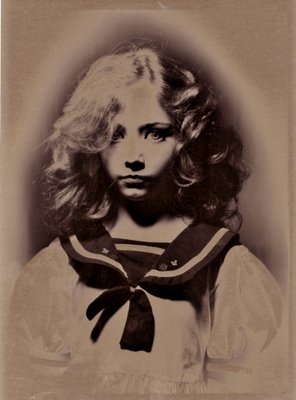
I turned my coal-house into my dark room, and a glaze fowl-house I had given to my children became my glass house! The hens were liberated, I hope and believe not eaten. The profit of my boys upon new laid eggs was stopped, and all hands and hearts sympathized in my new labour, since the society of hens and chickens was soon changed for that of poets, prophets, painters and lovely maidens, who all in turn have immortalized the humble little farm erection.
Having succeeded with one farmer, I next tried two children; my son, Harding, being on his Oxford vacation, helped me in the difficulty of focusing. I was half-way through a beautiful picture when a splutter of laughter from one of the children lost me that picture, and less ambitious now, I took one child alone, appealing to her feelings and telling her of the waste of my poor Mrs. Cameron’s chemicals and strength if she moved. The appeal had its effect, and I now produced a picture which I called ‘My First Success”. I was in a transport of delight. I ran all over the house to search for gifts for the child. I felt as if she entirely had made the picture. I printed, toned, fixed and framed it, and presented it to her father that same day: size 11 by 9 inches.
January 1865, Annals of My Glass House, Julia Margeret Cameron
You Only Live Twice - In Veracruz
Wednesday, April 29, 2009
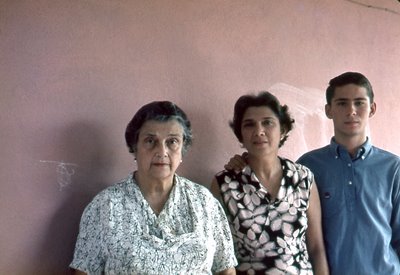
Some of the happiest moments of my life happened in Veracruz. I first saw the sea as an adult there. After having lived for some years in Mexico City’s high altitude I had forgotten that sound travels through the air.
My mother quit her job as a teacher at the American School in Mexico City in 1963, because of health reasons. She had a terrible case of Meniere’s disease with a constant ringing in her ears, a horrible almost constant nausea and the rapid deterioration of her hearing. Doctors told her that living at sea level might soften her symptoms. So she applied to work for a small American School in Veracruz where she would teach the children of the American workers of Alcoa.

After my first night sometime in 1963 I woke up to sound. Every sound seemed to be precise, clear and loud. It took me while to grasp that at sea level, sound really traveled not like in Mexico City’s thin air at 2224 meters.
For breakfast, my mother’s cook and helper prepared the most fabulous cheese omelet I had ever had. This was after my mother had said, “Favor, Petra, prepare un desayuno para el joven.” Please Petra prepare breakfast for the young man.”
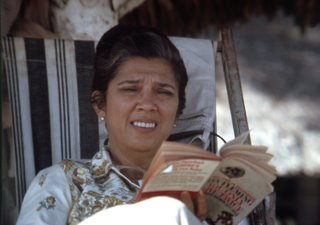
In 1967 I traveled with my soon to be bride, Rosemary. I told my mother jokingly that I would need some 3 in 1 oil to oil the hinges of the bedrooms. That first morning I heard my mother say, “Favor, Petra, prepare un desayuno para el señor.” Rosemary was still asleep and suddenly I had graduated from being a young man to a man! I remember that Rosemary spent most of the day taking showers. A native of New Dublin, Ontario she had yet to be accustomed to the humid heat of Veracruz.
It was in Veracruz where Rosemary and I went for walks on the malecón (a Spanish word for a seaside boulevard) and had tall cafés con leche at the Café de la Parroquia in the centre square of Mexico’s oldest city. We would watch the noisy trams go by and noisy but still pleasant marimbas would play on the street. For a few pesos you could request them to invent lyrics on the spot. They would sing to the merits and beauty of my blonde Rosemary. I smoked cigars and pipes at the time so I would go to the tobacconist on the Hotel Diligencias and pick some long thin Flor de la Costas. This was life at its best. We were young and it seemed that we could dream a world even if we had little money. We liked to sit on the zócalo (main square plaza) on Sundays. The young men would stroll in a clockwise direction (I am not too sure of that) and the young women in the opposite direction. On Easter Sunday these youths would throw at each other eggs that were full of confetti.
It was in 1963 when I first went to Veracruz that I first met three of my mother’s friends. One of them was German and she had a big clunky Toyota jeep like vehicle. She owned a store in town that sold Mexican curios. The other two were delightful American women (one of them looked like actor Strother Martin) who loved to read Ian Fleming and play bridge. I learned to play bridge from them as well as being handed down every Ian Fleming, James Bond novel as soon as it became a pocket book. I never bothered to notice that there was something odd. It was only in retrospect and many years later that I found out that my mother had befriended a coven of lesbians! There were some protests from the parents of the children she taught but somehow my mother stuck to her friends.
My grandmother lived with my mother for a while in Veracruz. Then she went to visit her son Tony in Egypt. When she came back she did not recognize us. In this picture my grandmother seems to be in that second stage. I must have taken it around 1965 when I returned on leave from my military service in Buenos Aires. It was around then when Ian Fleming’s You Only Live Twice appeared as a paper back. I remember my mother trying to read it in the glare of the sand of Mocambo Beach.
My mother’s house, which was also the school was on Martín Alonzo Pinzón. He and his two brothers had sailed with Christopher Columbus. Pinzón had been the captain of the caravel, La Pinta. For those who believe that Columbus discovered America there are now rumblings from those wanting to name Pinzón (who was an excellent mariner) as the co-discoverer.
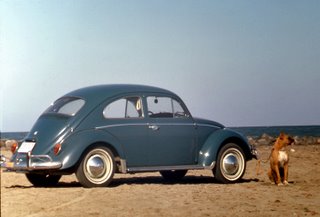
It was in Veracruz that I first learned to drive. My mother had purchased a brand new blue VW Beetle. She also had a very large boxer called Antonio whose tongue was so long that part of it was always sticking out. Rosemary and I would take the car and Antonio and walk him on the beach. When Rosemary and I got married, a few months after my mother most generously helped us buy our very own VW. To this day I remember with warmth and excitement those Friday night trips where Rosemary and I would drive, after our last English classes of the day from Mexico City to Veracruz. The trip took us from those 2224 meters to a sudden downhill to sea level by the time we crossed into the Veracruz State border near Córdoba. We would open the windows and we could smell that wonderful humid air that smelled of wet earth with a hint of the nearby sea. We could hear the insects and see the fireflies. Arriving very tired sometime around one in the morning to the welcome of my mother and Antonio’s barking was paradise.
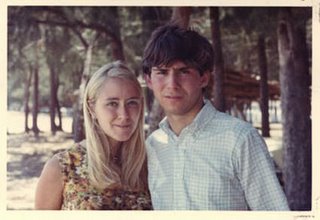
Paradise it was until one night when Rosemary went to the bathroom and I heard her scream. It seemed that the bathroom had been invaded by flying cockroaches. She soon learned to share our paradise.
The Plastic Hippos Of Disneyland
Tuesday, April 28, 2009

This is my first cousin David Humphrey. I took this Ektachrome in Mexico City while he was having his siesta sometime in 1961. He may have been 5. He was a likeable kid and I remember taking him for a walk in Chapultepec Park and the Mexico City zoo. It was there where David, unwittingly, taught me a lesson on the perception of reality. I proudly showed David the hippos which were basking in the sun, semi-submerged in an artificial lake. David told me, matter a factly, “ These hippos are boring. The ones in Disneyland make more noise and move more. They are not so lazy.” I pointed out to David that the Disneyland hippos were made of plastic and had internal motors that made them move. I told him that the hippos we were looking at were the real thing. David stuck to his guns and I was not able to dissuade him. After 1961 I never saw David again. From his brother Robin I have learned he is doing just fine, he is married and is a gemologist.
That evening when David and I got home I made a firm commitment that I would never go to Disneyland. In 1975 when Ale, Hilary, Rosemary and I drove to settle in Vancouver we stopped by Disneyland. I delivered my wife and daughters to the Disneyland entrance and I then maneuvered my way through the LA freeway to a big photography equipment store where I bought all the stuff I had been unable to buy in Mexico City. I had been teaching in Mexico City and when Rosemary suggested we move to Vancouver I had made the decision to start from scratch as a photographer.
Around 1980 we sent our daughters to visit friends in Mexico City. On the way back they met up with Rosemary in Los Angeles who was there on business. “My boss had left me a Cadillac so I took the girls to Disneyland.”
On September 11, 2001 early in the morning Hilary, her husband Bruce, Rebecca and Lauren were ready to go to the airport. There were going to Disneyland. Bruce turned on the TV to check the weather. They never went to the airport and both Rebecca and Lauren have yet to go to Disneyland. I wonder, are they are missing anything?
Two Rauls - One An Orange Cat
Monday, April 27, 2009
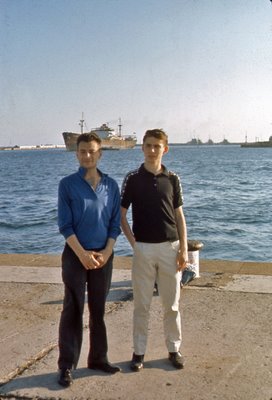
Two Raúls and a bit of a third have been on my mind these last few days.
When my youngest daughter Hilary was born in 1972 her godfather was Raúl Guerrero Montemayor. I first met him around 1963 at an uncle’s house. Raúl was born, I believe since he likes to waffle on this one, in the US. His father was Filipino and his mother Mexican. Raúl’s first cousin is actress Yvette Mimieux. Raúl looks so much like first Filipino president, Manuel M. Quézon that there have been persistent rumours that he is Quézon’s illegitimate son.
I met Manuel Quezon’s son, Nonong in 1967 shortly before I married Rosemary. I was staying with Raúl. My mother lived in Veracruz so while I was looking for a job in Mexico City Raul lent me his loft as a temporary living quarters. Nonong came to visit him from the Philippines and I noted that Raúl looked a lot more like the ex-president’s son than the real son did. Nonong soon gave me a nickname, Suput. It is a nickname that has stuck with those who really know me. In the Muslim parts of the Philippines like Mindanao, I would be shunned for being an unclean heathen.
I need not go into further details except to note that when I go to Goldilocks, the Filipino bakery on Fir and Broadway to buy “polvorones” or Filipino shortbread I am instructed to wite my name on a little sheet of paper to place my order. The Filipino women behind the counter then yell out the names. I have yet to hear them even whisper mine. They now know me and they simply say, “Andong, what do you want?” and I circumvent the little paper bureaucracy.
It was around 1964 that Raúl invited me to accompany him on a trip from Mexico City to Veracruz. I had not seen the sea since I was 7 and I had gone with my mother and grandmother to Mar del Plata in Argentina. I was attracted to the idea of a little pilgrimage to the sea. There were countless curves, steep hills and down hills. I remember Raúl constantly downshifting as he maneuvered around the curves in his VW Beetle. I remember our first look of the water and the pungent smell of salt, bunker oil and the sewer of the port of Veracruz. Only now I would assert that it was the smell has become a memory that seems to be the primordial soup of my existence. I lay to bed my trip to Mar del Plata. Here was a new standard. We swam in Mocambo Beach and I lightly scraped my face with the ocean’s sand (really the Gulf of Mexico) and felt clean. Raúl told me of the curative properties of coconut water. We had lots of it. We got the runs.
Raúl is now in his 80s and he still travels so he can practice the over 10 languages he speaks. He was delighted when I told him that Hilary had named her orange cat Raúl after him some 15 years ago. I could not tell him that it was a half truth as Hilary had also named him after actor Raúl Julia whom she admired.
Raúl, the orange cat has been missing for almost two weeks. Hilary cries. Rebbeca cries. Lauren is much too young to understand. This could be the first death that hits home for Hilary. When this happens it is when we really begin to suspect that our journey is a short one and that the 15 long years of a cat’s existence seemed to have passed ever so quickly.
John Cruickshank & The Persistence Of Print
Sunday, April 26, 2009
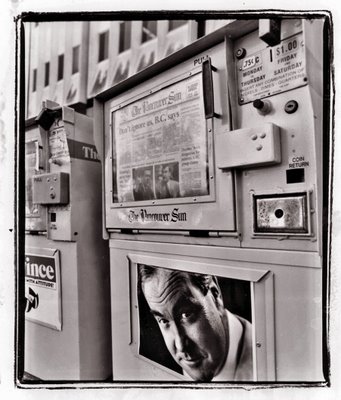
In my ever increasing photography classes (those who can’t, teach) I have been telling my students that until just about now, photography gave me access. In a world where even one of my neighbours, two doors down, drives a brand spanking new Bentley, access is the only real show of one’s perceived importance. It certainly is not wealth.
One of my fondest moments in my photographic career happened about 5 years ago when I went into the Vancouver Sun news room to talk to my friend Nick Rebalski. Rebalski and I had an “unwritten” method of operation. I would submit him an article which he would then edit and pass it on to his boss, David Beers who was the editor of a new and exciting cultural section of the Vancouver Sun called Saturday Mix. I had a pretty good batting average, 1000 % in baseball terms. Many of my articles appeared on the front of Mix and with a big picture.
As I was about to leave I was stopped by John Cruikshank (in photo, left) who was the Editor-in-Chief. He put his hand on my shoulder and told me, “Alex accompany me to my office.” We walked the length of the news room. Staff writes just stared. Inside his office, Cruickshank told me that my contributions to Mix were welcome and appreciated and that soon I would have an opportunity to contribute more as he had decided to get David Beers to “Mix” the rest of the paper.
Within days I was invited to lunch by a few Sun writers but Cruickshank’s plans were not to be. David Radler sent him to the Chicago Sun Times. Beers, without his mentor, was left hanging with no mandate. Beers finally left the Sun under circumstances that were all not that pleasant and Mix deteriorated and then disappeared. And my personal contributions to the paper did that, too.
I remembered Cruickshank (he is now publisher of the Toronto Star) yesterday as he figures prominently in an interesting article in Saturday’s Vancouver Sun written by David Akin.
There have been many articles in both print and web media on the endangered species the hard copy newspaper has become. Vancouver Sun’s fine columnist Stephen Hume has already written a couple on the subject and will write a third this coming Thursday. In fact Saturday’s full page article is the first of five more that will finish on Friday.
Cruickshank the optimist states, “There certainly will be newspapers in two years, five years, and 10 years time. They may be somewhat different [but] we’re a long way from disappearing as either news companies or as print operations.”
Coincidentally, it was Maureen Dowd in today's New York Times who found a far more logical reason to report for the persistence of newspapers. Dowd’s column deals with a tour she was recently given by Phil Bronstein editor-at-large of the money losing (a million a week) San Francisco Chronicle. Dowd writes:
His tour ended with cold comfort, as he observed that longer life expectancies may keep us on life support. “For people who still love print, who like to hold it, feel it, rustle it, tear stuff out, do their I.F. Stone thing, it’s important to remember that people are living longer,” he said. “That’s the most hopeful thing you can say about print journalism, that people are living longer.”
For my part I would like to add a few more to that startling prediction.
Numerous New Yorker cartoons have appeared through the years of Mr. Smith reading his paper at the breakfast table while ignoring his poor suffering wife, a lowly domestic before women’s lib. When women’s lib happened the cartoon became one of selfish alienation and as both sat down at the breakfast table but read different sections of the paper or perhaps he the Wall Street Journal and she USA Today.
A New Yorker cartoon that would show Mr. and Mrs. Smith reading the day’s news on line on side by side computer monitors seems most unlikely. The method could be as it is at an American friend's house, after dinner. He is married. She smokes, he doesn’t. She is upstairs in the bedroom with her computer, a martini and a cigarette. He is in the basement (as far from second-hand smoke) with his computer, a coffee or a beer.
My point is that reading a hard copy newspaper is a social event, a pleasant social event, that happens in three-dimensional space and not facing the two dimensions of computer monitor. In my house it happens in bed.
Now that Rosemary no longer works we wake up later at 7:15. I go downstairs to make breakfast (coffee for her, tea for me, hot cereal with brown sugar for her, two unbuttered scissor rolls for me, orange juice for her, V8 for me). I feed our cats and then when they go out into the garden I pick up both our Vancouver Sun and the New York Times. I bring the papers and our breakfast up in a wicker tray. We make sure we find the daily comics in the Sun and then we each read each paper in no particular order. We discuss the news and we tell each other of interesting columns or articles. After all this we get out of bed to face the day. Reading those papers in bed, our head propped up by pillows is an experience, a shared experience, that will never be supplanted by "his" and "her" laptops, at least not for the next five years if we are to believe John Cruickshank.
Alexandra, Hilary, Rebecca, Lauren, Abel, Cain & Joseph
Saturday, April 25, 2009

When I started this blog in January 2006 I had no idea what blogging was all about. It took a while for me to figure out how to move pictures around so that copy would wrap around them as in a magazine. But it was the content that took a while. Early on I decided to write about Rebecca, my oldest granddaughter (she was 8) and my relationship with her. At the time her younger sister, Lauren was 3. Lauren was a difficult child who did not like to eat anything and as things looked it seemed she would demand to be breast fed until her teens.
Lauren not only resembled and resembles my daughter Hilary but in many ways she is much like her in personality. When Hilary was 3 and her older sister Alexandra was 6 we drove in our VW Beetle to San Francisco. While there Hilary refused to walk with me or hold my hand and demanded to be held and carried by Rosemary. It made me furious and jealous. Because we had been teaching English in Westin Hotels in Mexico City we were given courtesy free stays in the best Westin Hotels. In San Francisco we stayed at the legendary St. Francis. One early morning we sat down for breakfast in the elegant dining room and Hilary began to cry. Soon she was screaming. A tuxedo-wearing waiter came to us and asked, “Madam, is there anything I can do for the young lady?" Rosemary answered, “I’m afraid not, unless you can bring her beans and tortillas.” The trip, thanks to Hilary, was a nightmare. We expected that her elder sister keep her company and take care of her. It seems now that Ale from an early age had the burden of being her sister’s watcher.
Through those years Ale grew up and was independent. She made friends easily and did well in school without really trying. In our Arboledas neighbourhood, which was on the outskirts of Mexico City, I was known as the man whose daughter would lie down on the sidewalk to sleep siesta. This is something that Hilary perfected by age 3. She also had the curious habit of looking at you by turning her head sideways so that both eyes coincided as if she were looking at you with only one of them. This sideways glance in Mexican Spanish is “mirar de re-ojo” and it generally unsettles most people. Some think it might be associated with “mal-ojo” or bad eye, a witch’s glance.
When we arrived to Vancouver in 1975 we both had to work so it was Ale’s job to take care of Hilary. I remember the first day I took Hilary to daycare. She cried and cried and I felt so sorry I almost brought her back home. For some years my cruel suggestion that if she did not behave I would take her to the daycare was an efficient method to keep Hilary in check. I regret that now.
School for Ale was simple and a social endeavour. She went to meet her friends and got decent grades even though she did not study much. With Hilary it was different. In school she was shunned for being different and only now have I found out that she was beaten up with frequency. She made few friends and for many years, our Vancouver evenings were spent with Rosemary working with Hilary on her homework.
Our proudest moment happened when we went to Hilary’s graduation at Simon Fraser University. Her Bruce Stewart had Rebecca (1) in his arms as she lined up to get her diploma.
It is difficult for me to answer the question as to which of my two daughters is my favourite. Perhaps when they were both young, Ale, as my firstborn had that extra quality that made me favour her. But as years have passed by I have come to understand that by deciding that Ale in her startling independence did not need too much of my attention and concern, I did not give her the affection she craved.

Now one is 40 and the other is 37. I seen in Ale more than a daughter but a real friend. We talk on the phone we, e-mail, we visit in Lillooet and it is very pleasant. With Hilary I feel that I am in the presence of my mother. She looks a lot like my mother and has my mother’s sweetness. I watch her take care of her daughters with a love an attention that rivals my mother's. Which is my favourite? About the only way I can safely answer that is in the way I answer to, “What’s your favourite rose in your garden? “ “It depends on the day, the week and the month!”
As Rebecca, 11, signals her own independence and approaches her teenage years I have now noticed Lauren, who at age 6, is sweet and loving. She no longer screams or cries at the table. She eats almost anything even though she must smell it if it is something she has not eaten before. She wants to be photographed while Rebecca does everything possible to avoid it. When I cook, Rebecca is at the computer or watches TV. Lauren brings the step stool and so she can watch me cook. She tries to help. Rebecca refuses to wear dresses. Lauren wants to wear dresses.
Which one is my favourite? Is this a fair question? This question became an issue with the first born human. And it seemed to make it all worse that it was God who in the story was the one who had made Abel His favourite. Jacob showered his son Joseph with more love and attention. His jealous sons sold him to slavery in Egypt. It would seem then that it is difficult to show impartiality with one's children. As on only child I never had that problem at home.


Lauren is endearing herself to me much in the same way as her sister did in years past. Children go through similar phases. Lauren is going through the “I like my grandfather” phase now. But I can also discern a peculiar difference. This peculiar difference is exciting and now I long to see not only Rebecca tramp into the house but also my dear and sweet Lauren. This is because it has taken me all this time to notice beyond how different they both are and how comparison is a silly method for showering one’s affection. It just happens.
Susan Hogan, Bill Richardson, Bunny Watson & A Remington Portable Model 5
Friday, April 24, 2009
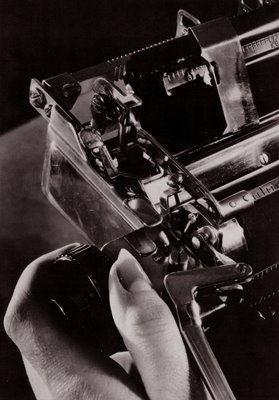
Thursday night's performance in Granville Island, of the Art Club's Age of Arousal (a play written by Linda Griffiths and directed by Katrina Dunn) initiated an activity in my head similar to that primitive computer game Pong. Ideas and associations were bouncing off and I almost became giddy with my excitement. I had an intense Bunny Watson moment. What's that? Read below.
Bunny Watson was a Canadian radio program, which aired Saturday evenings on CBC Radio One and Sunday evenings on CBC Radio Two.
Named for Katharine Hepburn's librarian character in the movie Desk Set, the show was hosted by Bill Richardson, below, right, and was produced by Jennifer Van Evra and Tod Elvidge in Vancouver. Inspired by the Hepburn character's quote that she "associates many things with many things", Richardson explored a particular theme each week through his personal associations with music, literature and film.
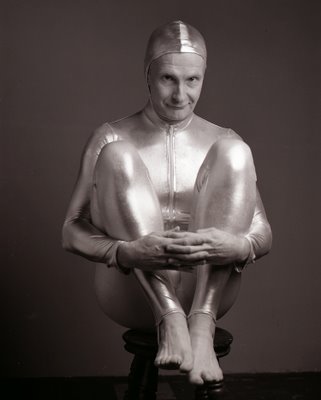
The show first aired in the fall of 2004. In one of the show's most notable episodes, on October 2, 2004, the poet and performance artist Meryn Cadell came out as transgender.
The program ceased to air on the full CBC network in 2006, although repeats continued to air in Nunavut until the summer of 2007 to fill a scheduling hole created by time zone differences, and on Radio One's Sirius Satellite Radio channel to fill a scheduling hole created by the satellite channel not broadcasting local programs.
---------------------------------------------------------------
The above is from Wikipedia. I can only add that Bunny Watson was my favourite CBC Radio program. We had the opportunity to enjoy a dazzling and cerebral program but the ratings must have been low so the program was axed and now we have lots of Pablum. And if you must enjoy the dazzling and cerebral (and funny) Bill Richardson then "your thing" better be the opera.
In January 2006 I started this blog. Its framework is inspired by Richardson's Bunny Watson. I like to somehow bring together things that outwardly may seem disparate. I firmly believe that our ability to associate is what really makes us human.
If I digress in too many directions, and bore you, don't quit quite yet. Rosemary and I were sitting very close to theatre critic Jerry Wasserman. I watched him during the performance. Like us he did a lot of laughing. I am sure he has written a glowing review here. Now you can quit as I will now digress.

Right off the bat the stage was designed to look like the front end of a vintage Remington typewriter. The curves of a Remington are nearly as sensual as that of a woman. When each act and scene was typed on a projected screen and I heard Chris Hind's (Sound Design/Composer) rendering of a typewriter in action, it was sensual music to my ears. I remembered my grandmother (she was a terrific typist and a stenographer) typing on her Remington Portable Model 5. I now own that precious jewel of a machine.
When Susan Hogan, above, centre (she plays veteran suffragette Mary Barfoot) appeared on stage she threw me back to the last time I had seen her in person. I had photographed her in Egmont, B.C. the summer of 1979.
Laara Sadiq walked on stage. She is the self-styled "definitely odd" Rhoda Nunn who works for Mary Barfoot who runs a typing school for girls of possible ill-repute or down and out. She is precise, quite cold (she makes a wonderful reversal towards the end of the play that had this 66 year old feeling things he should not be feeling if heart attacks are to be avoided.) in her demeanor to Hogan's warmer approach. I was suddenly thrown into thinking of that beautiful William Wyler film The Children's Hour (1961) with Audrey Hepburn and Shirley MacLaine. The two women run a private school for girls and are accused by one of their nasty students of being "definitively odd".
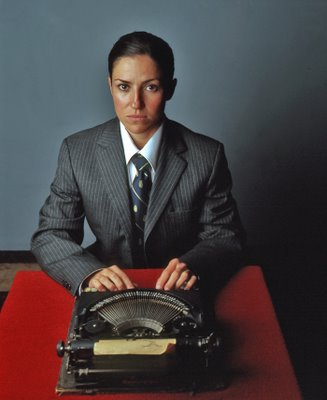
As soon as Kerry Davidson as Virginia Madden, Gwynyth Walsh as Alice Madden and Jennifer Mawhinney as Monica Madden walked on stage I was transported to one of my favourite films of all time, George Kukor's 1939 The Women. The cast was stellar as you had Norma Shearer being almost friendly with Joan Crawford plus there was Rosalind Russell, Joan Fontaine and the luminous Paulette Goddard, plus of course Hedda Hopper! The performance of these Madden sisters was no less stellar.
When Jennifer Mawhinney's (she looks terrific in a suit, tie and moustache) alcoholic antics hit the stage I had another Bunny Watson moment. She is not at all like Marjorie Main (wonderfully gruff in The Women) but somehow here was a character that had the same matter of factness that Marjorie Main exploited in her Ma Kettle films. And of course Berlin will now have an extra meaning (a funny one) after Jennifer Mawhinney's performance.
But when the only male, Martin Happer, as Everard Barfoot, made his lusty entrance I too felt I was kicked in my nether parts (there is such a line between Rhoda Nunn and Everard Barfoot as they first repel each other). Then when one of the magnets was turned the attraction between them was primal. Warning, the magnets have nothing to do with this play, it's just another Bunny Watson moment! There were no men in The Women! Wait! That dog that walks into one of the scenes in the film. It was a male dog. Ha! Everard Barfoot is the dog of the play.
The funniest moment in The Age of Arousal happens when the women, one by one, faint amply proving one cannot faint twice in quie he same way in the waters of the River Swoon. And yes there is that nasty girl in The Children's Hour who also fakes a fainting spell but is ignored by the good doctor, James Garner.
All in all The Age of Arousal was a play that challenged me, but still managed to make me laugh, lots. After having seen a few plays directed by Ms. Dunn, below, right, I have come to the conclusion that she has a delicate touch and she never makes her presence as a director known. I think I like that. I like that lots.
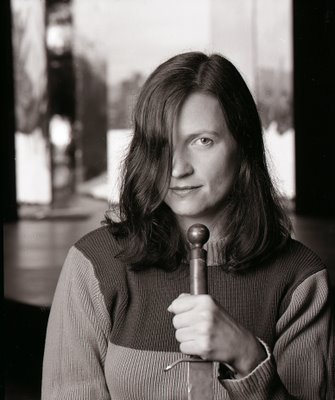
The young lady dressed like a man with my grandmother's Remington Portable Model 5 is Ivette Hernandez. She is from León, Mexico. Why is she posing dressed as a man? Could she be definitively odd? No. The explanation can be found here. The first photograph of the Royal typewriter was taken by my favourite female photographer, Margaret Bourke-White. She took this picture in the early 30s when people had the novel idea that machines and engineering would save the world and make it better. She took this photograph in the spirit of Linda Griffiths' entertaining play, The Age of Arousal. The play runs until May 9.
I hope I will not have to wait another 30 years to see Susan Hogan again! And if Bill Richardson's Bunny Watson were still on air I could look forward to next week's program on Lillian Hellman, Clare Boothe Luce, Nora Charles and Linda Griffiths.
Don Harder - The Distillation Of Perfect Sound
Thursday, April 23, 2009
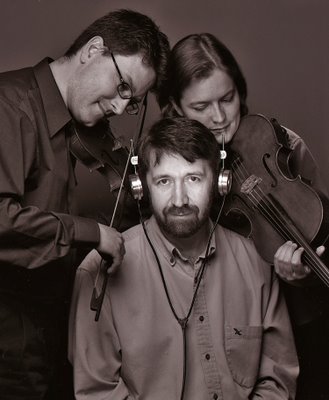
At last Friday's concert of the Turning Point Ensemble I spotted a smiling face up in the sound booth. It was that of CBC sound man extraordinaire Don Harder. There is a story that has been going around Vancouver that says that when English virtuoso baroque violinist and conductor Monica Huggett visited Vancouver for a concert she attempted to lure Harder back to Europe as a sound technician and recorder of her future concerts and recording sessions. That Don Harder is still in Vancouver, testifies to the Old World's loss and our continuing gain. Many, if not most of the recordings of classical and new music concerts that you hear on CBC Radio are Harder's work as must also be a long string of CBC CD recordings that have won prizes. When I had to photograph Don Harder in 2002 for the Straight I came up with the idea of taking his portrait with a couple of inspirational angels. I called violinist Paul Luchkow and his violist wife Glenys Webster . They were delighted and they told me many other stories of Harder's reputation in Vancouver as a sound recording engineer.
The placing of musicians at all the levels of the Telus Theatre of last Friday's concert of the music of Charles Ives (see link above) was a stupendous experience for the audience but it must have been a recording nightmare. The sound came from different places so it would surely have taxed but probably delighted Harder's efforts to record the concert. I saw the hanging mikes so he must have been recording the concert. It is my hope that this will be announced and broadcast so we can enjoy the concert all over again and perhaps it will not only be our city's musicians but also our listeners who will realize we have a national treasure in Vancouver. He is alive and well and his name is Don Harder.
This glowing exposition of Harder's talents is in now way a personal effort on my part to apologize for that one uncontrolled sneeze of mine in Friday's concert. But I do apologize knowing with certainty that Harder will eliminate it with no problem.
Of Gardens and Granddaughters
Wednesday, April 22, 2009

For many of my 30 years in Vancouver, I was plagued by Italian cars with a slipping clutch. My mechanic, Girolamo Clemente, would say, “It could fail today, in a week, or in a year. I can’t tell you when.” So I became used to nursing a slipping clutch and identified my own life with that of my cars. The trick with both is to drive to the destination with minimum expense for maintenance and to synchronize mechanical failure with arrival. At 66, I often remark to my friends that, after half a century of existence, the rest is a bonus and I need not worry about keeping fit, running, or eating well to live longer.
My granddaugthers, eleven-year-old Rebecca and six-year-old Lauren have changed all that.
It all started when Rebecca was six and she asked me why I had my hand on the shift lever of our family car (which my wife has named Sophie). “Papi,” Rebecca said, “Sophie is an automatic.” I was speechless. Since then I have wanted to live as long as I can, to see what she will come up with next.
Rosemary and I work on our heavy-duty corner garden in Kerrisdale for more than 10 months of the year. The work seems to get tougher every year. The thought of a smaller garden has been an attractive alternative, but we discarded that idea the moment Rebecca began to walk. She would run into the house and rush through the kitchen and out to the backyard. We have come to understand that we are going to stay with our large yard for Rebecca and her sister Lauren, as the garden will be their bank of future memories.
Rebecca’s education in the garden began almost as soon as she was born, with our babysitting chores, usually on Saturdays. On nice days, we would put a blanket on the lawn and lie down to listen to “Saturday Afternoon at the Opera” on CBC Radio. By the time Rebecca was three, she was interested in smelling the roses, and by the time she was 8, she demanded we take her to Madama Butterfly.
In June of 2003, we traveled with Rebecca to the American Hosta Society national convention in Washington, D.C. One day, we hopped on the Metro to go to the zoo, and Rebecca observed a fellow passenger who had an AHS convention name tag. “Do you have Hosta ‘Janet’?” Rebecca asked the woman. She replied that not only did she have Janet, she also possessed a splendid specimen of June. Rebecca came back with Marilyn, Mildred Seaver, and Mary Marie Ann, all hostas in our garden. We knew then that Rebecca had not only an uncommon interest in plants but also a very good memory. Coming home on the airplane, Rebecca clutched a plush cat given to her by the Hosta Queen herself, Mildred Seaver, which Rebecca instantly named Rosa. Packed in our luggage was a clandestine import: Rebecca’s miniature Hosta ‘Cat’s Eye’.
I have learned to look at our garden through Rebecca’s eyes. I tend to buy plants with stories, so that I can tell them to her; I have played her Dvorak’s cello concerto performed by Jacqueline du Pré, so that both of us can imagine the music when we look at her lovely white namesake, Rosa ‘Jacqueline du Pré’.
Rebecca’s favourite pastime is our bamboo-stick game. With stick in hand, she is ready to run to mark the location of any particular rose. I might mention a rose that smells of magnolia, soap, and lemon (‘Fair Bianca’) or ask her to spot the location and name of a red rose with a white edge ( Rosa ‘Baron Girod d’Lain’), and she knows where to find most of my 60 roses. After I showed Rebecca the scans I have made of roses by placing them directly on my flatbed scanner, it wasn’t long before she started running into the house with seeds, leaves, butterflies, bees, wasps, and even a fly that she had swatted, demanding: “Scan this one.”

There is a bittersweet paradox in all this. As Rebecca pushes me in the direction of my youth and invigorates my life, she is growing up. I have taken many pictures of her in the garden. At first she would strike poses while asking me, “How’s this?” The photos were intriguing, but when I showed them to Rosemary, she was disturbed by them. It didn’t take me long to figure out that the poses were of a child wanting to look like an adult. They remind me of the 19th-century portraits of Alice Liddell by Reverend Charles Dodgson (Lewis Carroll). I don’t worry too much. Now Rebecca objects to having her pictures taken but her sister Lauren is most keen. The wonderful experiece of educating Rebecca through the garden is now happening all over again with Lauren.
Meanwhile, I can’t wait for next Saturday to tell Lauren as I once told Rebecca how my Taxus baccata ‘ Standishii’ brings to mind the long bows of English yew that defeated the French at Crécy and at Agincourt. Somehow now not only because of Rebecca but also because of Lauren I want more borrowed time.
That First Take Syndrome
Tuesday, April 21, 2009
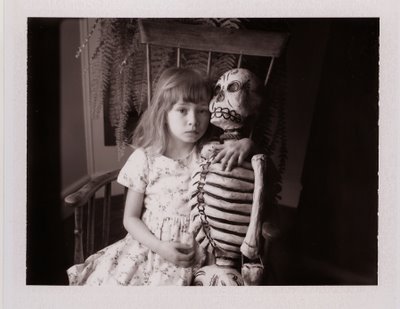
I remember watching the making of several CBC drama series, particularly on location on the Sunshine Coast. Since this was some years ago they used one camera and film. It was a surprise to see how they would focus on an actor or actors from one point of view and the actor would say all his lines. Then they would move the camera to a new position (the actor's side, as an example) and repeat it all over again. The film editor would then cut and splice the different takes into what would become the final edit. This to me was startling as my pervious observations in the CBC studios on 500 Hamilton had been for variety shows where they might have two main cameras (on heavy rolling stands), one on a boom, and a fourth would be a what was then considered a compact camera that was hand-held (it was bulky and heavy).
During these drama series they would sometimes make 10 or more takes of the same scene from the same vantage point. Often the director, frustrated after many takes, would look at that first take and he would ask his assistants, “What was wrong with this first take?” After some silence he would then holler, “That’s a keeper.”
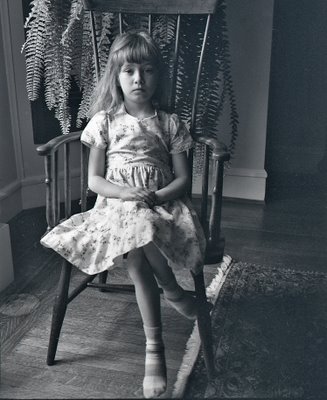
I don’t shoot video of movies. In the parlance of film making (even when the film making is digital and no film is used) I am a stills photographer. A stills photographer shoots promotional stills that are then used in publications to advertise the production. Being called a stills photographer annoys me as I like to point out to film photographers (not quite the same thing as cinematographers) that we stills photographers were shooting still pictures at least 50 years before moving pictures were regularly taken. And furthermore I would now add that Eadweard Muybridge took the first moving pictures with banks of still cameras. This would mean that the first cinematographer was a stills photographer.
But there is one peculiar element that this stills photographer shares with those finicky directors who demand countless takes and then decide on that first one. I have observed this syndrome with Polaroids. I call it the First Polaroid Syndrome. What this means is that after that first good, interesting and sometimes remarkable first Polaroid, secondary Polaroids and the use of “real” film in a “real film” stills camera will not produce anything that matches that first picture.
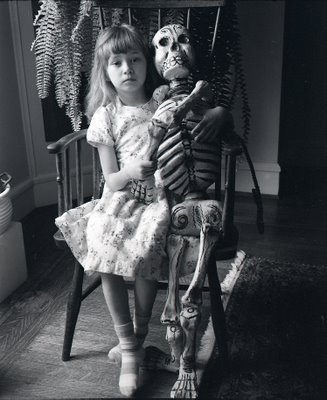
Now that Polaroids are bankrupt history I use an instant film made my Fuji. I have determined that this film is far better than the Polaroid but that it lacks a bit of the nice granularity of Polaroid so that scans lack a bit of texture and the Fuji instant film scans more like a well printed classic b+w darkroom print. But you can judge here that First Fujiroid Syndrome.

The opening picture of Lauren is the Fuji one. The subsequent ones in b+w are taken with my very last Agfa ISO 400, 120 roll film. And the colour one is Ektachrome 100G. Both the Fuji and the Agfa pictures are with available window light. For the Ektachrome I used a softbox on the left.
I think the Fuji first take has a charm that is a bit lost in my other efforts. When I mentioned to Lauren that I liked how she crossed her legs she told me, "Papi its just like "Pancho el esqueleto". Pancho is a Mexican papier-mâché squeleton given to me last summer by Abraham Rogatnick. Rogatnick who is about to celebrate his 86th birthday is trying to get his life in order so he can die in peace. This means that he is getting rid of stuff. Pancho sits on a chair, with his leggs crossed, in our living room.
Not Bored With Village Of The Damned
Monday, April 20, 2009
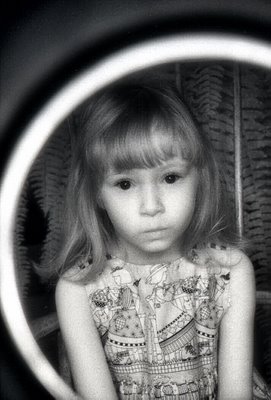
In the late 50s and early 60s I went on a science fiction novel binge and I read everything I could find including (not my favourites) short stories. I read Heinlein, Asimov, Sturgeon, Clarke, Farmer, Kornbluth, and both Gore Vidal (Messiah) and Kurt Vonnegut (The Sirens of Titan) who were then known as science fiction writers. I also read John Wyndam’s The Day of the Triffids and The Midwich Cuckoos. The later was filmed in 1960 as Village of the Damned. The Midwich Cuckoos and Theodore Sturgeon's More Than Human were particularly to my liking because the topic was about human evolution evolving from changes in the body to that of changes in the mind. In both novels humans became social "hyper-animals" much like bees and what one knew the rest instantly knew. I am charmed now to find out that particle physicists assert that two electrons on either side of our universe can somehow converse instantly.
Around 1964 I met the director of the film Wolf Rilla who lectured us on his film at the Israeli-Mexican Cultural Institute. He told us how the trick of the strange eyes was performed. Still photos were taken and the eyes were bleached out. When the children were doing there thing in the movie the camera would go from a wide shot and end up in the modified still. This, of course was how directors managed in the age before special effects.
This film left a profound impression in me. It was one of the few films were the great English actor George Sanders played, not a villain, but a sympathetic and understanding good man. This was far from his hateful role as the children’s author Miles Fairley in one of my favourite films of all time the 1947 The Ghost and Mrs. Muir with Gene Tierney and Rex Harrison and directed by Joseph Mankiewicz. Village of the Damned managed to be scary with little gore and no special effects. It was a subtle film done well.
In 1978 I had photographed my daughters Hilary and Ale with b+w infrared film. When I noticed Hilary’s blonde bangs I immediately remembered the film. I enlarged the negative and a couple more and called the trio of pictures The Midwich Cuckoos.
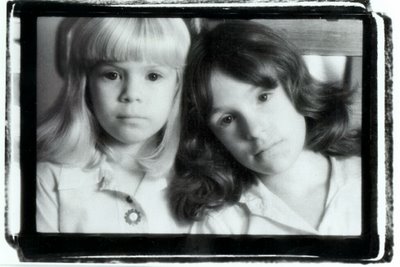
In my campaign to educate my two granddaughters, Rebecca and Lauren I like to show them films that, in the opinion of their aging grandfather, have relevant and intelligent content. Last week we sat down to see Village of the Damned. As soon as it began and Rebecca noticed that it was in b+w she said, “How can this be a scary film if we cannot see the blood?” I said nothing and soon both of them were silently watching the film with lots of interest. After the film they both went to our guest bathroom to look at the pictures of their mother and aunt on the wall. When they returned I noticed Lauren’s blonde bangs and…
On Saturday I photographed Lauren with Kodak Infrared film. Perhaps the look is different this time around as I used a ring-flash instead of my normal soft box. But Lauren still looks scary and so does her sister in the accompanying snapshot. Lauren was most cooperative and delighted but she did say, “You are going to put a picture of me on the wall, aren’t you?” It seems I will have to. I took some normal shots with colour film and some of them are delightful. One of them will be up on the walls soon.

At the end of our viewing of the film I told Rebecca that George Sanders had committed suicide and left a note that said, “I was bored.” She became quite serious and Rosemary winced at my telling her the story. According to the records:
He had at one time 7 psychiatrists, but they were of little help because in 1972 he took seven tubes of Nembutal in Barcelona, Spain and ended his life. His suicide note read:
"Dear World: I am leaving because I am bored. I am leaving you with your worries in this sweet cesspool."
But there is another version that is a tad kinder and more positive:
“Dear World, I am leaving you because I am bored. I am leaving you with your worries. Good luck."

Shostakovich, Stalingrad, Kharkov & Kursk
Sunday, April 19, 2009

Around 1972 my friend Jorge Urrechega sold me (cheap) a new transistor (one of the first in those days) Acoustic Research amplifier with an accompanying and lovely Acoustic Research turntable. The turntable was a beauty of design and the amplifier had knobs that were the absolute necessary ones (5) all made of solid brass. I immediately bought an expensive Shure cartridge. I was almost all set for listening to good music as it should be listened to. Except I had no decent speakers and no way of getting any in Mexico City where there was an import ban on anything manufactured in the US. Jorge would come and we would play Vivaldi’s Gloria and Richard Strauss’ Also sprach Zarathustra, Op. 30. When the latter began with its fanfare that ended with a very low pedal bass sound from the organ Jorge would wince and almost cry. “You need some good speakers,"he told me. “I suggest you get the best that you can afford and these would be the Acoustic Research AR-3As."

I had befriended one of my neighbors who lived at the end of our block in our Mexico City suburb of Arboledas. Alfarache was a blond/redhaired engineer who worked for the government petroleum company Pemex. I played volleyball on the street with my other neighbours but Alfarache disdained all sports. He was much keener about the weekend domino sessions. He was very good. But what separated him from most of my neighbours and made him somewhat of a loner was his penchant for listening to classical music, very loud in the comfort of his home. He looked down upon popular Mexican music and abhorred American pop. I guess he was a well-read snob. I liked his kind of music.

I told Alfarache of my problem. With a smile on his face he told me, “We are going to order a couple of hydraulic pumps from Houston and bring them into my office. I will deliver them to you in a couple of weeks. Now give me some money to buy them.”
Two weeks later Alfarache arrived at my door and we unpacked the most beautiful speakers (AR-3As) I had ever seen. We connected everything and I was just about to test my Strauss when Alfarache interrupted me, “Permit me Alex. Let’s listen to this first. And let’s play it real loud.” It was Dmitri Shostakovich’s Symphony No.5, Op. 47 with Kirill Kondrashin directing the Leningrad Orchestra.
I cannot stress here how this symphony changed my outlook towards Russian music. I had always only just tolerated the overly romantic Tchaikovsky. Alfarache mentioned that the second movement had a piano part where the piano sounded like the real percussion instrument it was supposed to be. That was the case. I remember it was a hot day but as the music played I was transported to a Russian winter. To this day this symphony is my favourite symphony.
Last night I went to see a live performance (my first) of Symphony No.5 at Shaughnessy Heights United Church. The orchestra playing it was the Vancouver Philharmonic Orchestra directed by Jin Zhang.

I went with some apprehension that I would find the performance lacking. I should not have been concerned. The performance was all that I imagined it to be. The piano part was as it had to be and the rest of the orchestra fluctuated between a bitter sweetness to loud triumphant parts. It was in the fourth and last movement, Allegro non troppo that I saw five percussionists all smile as they smashed their instruments with no apparent restraint. From the vantage of my seat on the fourth row it was really loud, it was gloriously loud. I am sure that Alfarache would have smiled and told me, “This is how music must be heard.”
But something else happened during last night’s performance. That first movement is an extreme cold and sobering experience. It is of despair. For me it is about the siege of Stalingrad even though I know Shostakovich wrote this work in 1937. I know that the subtitle of the work (he was attempting to rehabilitate himself with the Russian authorities and perhaps avoid being sent to Stalin’s gulag who had hated his last work, the opera Lady Macbeth of Mtsensk) A Soviet Artist’s Practical Creative Reply to Just Criticism. As the music progressed I saw tanks and imagined their rumbling and the roar of their guns. I saw plains of snow and Russian and German soldiers in long winter coats. I could almost hear the sound of the tank's metal tracks.
The German army was soundly defeated by the Russians at Stalingrad between November 1942 and January 1943. Then at the Third Battle of Kharkov, between February 20 and March 18, 1943 the Germans under the command of General Erich von Manstein almost compensated for their prior loss. And then between July and August 1943 the Russians defeated the Germans in one of the biggest tank battles of all time at Kursk. Tanks figured in two of these battles. In the end the Russian tanks were victors over the German tanks. While some of the German tanks may have been better machines they could not compensate for the many more tanks that the Russians had at their disposal.
When I heard the kettle drums in the last movement I heard the victorious Russian tanks in pursuit of the Germans who lost 1000 tanks and 100,000 men.

When I arrived home I went to my Yugoslavia file. I remembered I had photographed some tanks in a park by the Danube in Belgrade. I am sure amongst these there must be some of those Russian tanks.
Addendum courtesy of Ian McGuffie
First Photograph: German Stug III assault gun. That is a fixed "turret" that does not turn. To aim gun, tread turning was used.
Second Photograph: German Mark II Panzer and behind American M III Stewart
Third Photograph: Front view of M III Stewart
Fourth Photograph: German Mark IV Panzer. Ian McGuffie further comments that the Russians used American tanks (which they hated) in a Lend-Lease agreement with the US. He cannot understand why there are no Russian tanks in the Belgrade collection.
The Unanswered Question Satisfied Us Twice
Saturday, April 18, 2009
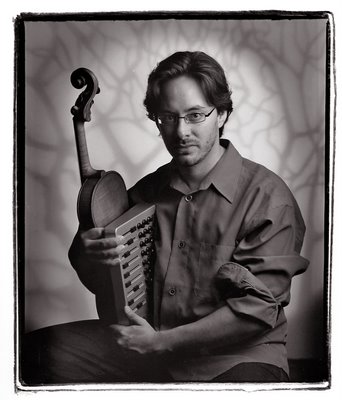
In 1972 I took my Mexico City high school class to Bellas Artes the birthday cake edifice that houses many cultural events of the city like opera and the symphony. I took them to see a special concert that featured, The Unanswered Question (1906) a not often played composition by American composer and life insurance guru, Charles Ives (1874-1954). I had been listening to Ives in the 60s. His music was virtually unlistenable to me but the more I played his recordings the more familiar the chaotic dissonances seemed to me. The beauty of The Unanswered Question, a 6 minute long composition, is a haunting trumpet solo that is all melancholy. My Mexico City class was curious as to why this composition featured two conductors. The main conductor directed the orchestra and the first violinist directed the string section. It seemed to be exquisite organized chaos.
Like English amateur gardeners, historians, archeologists and explorers of the 19th century, Ives felt it was anathema to try to make money from what he liked to do best which was to compose music with his own personal signature. So he started his own life insurance company and created innovative ways of selling life insurance packages. His method made him a millionaire many times over and his techniques are still an insurance Bible today.
Not bothering to please people with his music, Ives defended his polyrhythms, clashing harmonies and dissonances. He had zero tolerance for the wimps and mollycoddles who shuddered, or worse, hissed, at new music. He was famous for standing up at concerts and bellowing at such offenders, “Stand up and take your dissonance like a man.”
To me Ives is like a Champagne sherbet used by the French to cleanse the palate between different courses. If I have been listening to overly sweet music, Ives clears my ears just fine. And I must admit that after a while his music can even seem melodic in certain parts.

It is for the above reasons that my friend Graham Walker (he is up for any music that is challenging) and I went to the Turning Point Ensemble’s Living Toys: Thomas Adès/Charles Ives concert at the Telus Studio Theatre at the
Graham Walker was familiar with the Telus Studio Theatre as he and the firm he works for, Karo Design, created the signage for the whole Chan Centre. But neither of us had been to the venue for a concert. This was a rewarding revelation. Turning Point Ensemble violinist Marc Destrubé remarked to me, “This place reminds me of one of those tiny opera houses in Italy that may have burned down and only the structure remains.” That pretty well describes the shape of the little theatre with its excellent acoustics. You can either sit on the main floor in a tight semi-circle or do the same in three levels or tiers.
Both Walker and I loved the experience. Besides Ives there was the English composer Thomas Adès (1971) with his composition Living Toys about a young boy who dreams about being a bull fighter and an astronaut and then imagines his own heroic funeral. The piece had lots of noise like castanets, the sounds of bulls and bullfighting music and finally the sounds of the muffled drums of a funeral cortège. Watching the musicians (an unusual contrabassoon played by Ingrid Chan, a bass clarinet played by Caroline Gauthier, David Owen, English horn, and a pocket trumpet (it looked like a toy!) played by Marcus Goddard.
But we were all there to listen to that Unanswered Question. Goddard played the trumpet from up in the rafters and the band was divided into a string section in one corner and a woodwind section in another. We were not disappointed in the performance. It emphasized Simon Jenkin’s column I had read in the Guardian on Friday. There is not way that his Ives performance could have been as appreciated and enjoyed either in a downloaded recording or on YouTube. The last piece of he evening was Ives’ Three Places In New England. The piece as performed last night was a world premiere as each one of its three movements was arranged for a the smaller Turning Point Ensemble by Marcus Goddard, Michael Bushnell and Owen Underhill.
We were most entertained, but not as blown away as by local composer Stefan Smulovitz’s - the still unanswered question - complete with that wonderful solo trumpet and with many extra surprises. These surprises involved solo musicians spread around the tiers of the theatre. We had Marc Destrubé behind us and from our vantage point we could see virtuoso clarinetist François Houle. On the floor, trombonist Jeremy Berkman played into a special microphone and the reverberated sound was piped in through the sound system of the theatre. This was our favourite performance of the evening and it left us with a happy feeling that indeed Vancouver is lots of fun if you turn off the TV and venture out.
I also reflected that the Turning Point Ensemble within six months has given us Olivier Messiaen’s Quartet For The End Of Time and Erik Satie’s Relâche and now all that Ives. At the same time this was the year that we heard the complete Brandenburg Concertos with Richard Eggar’s Academy of Ancient Music brought to Vancouver by the shrewd folks at Early Music Vancouver.
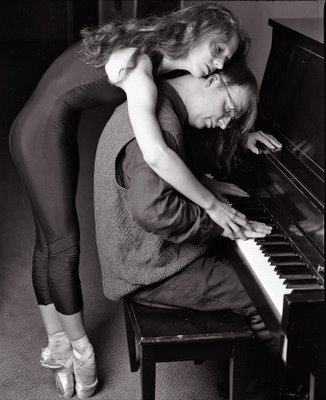
In the pictures here you see first, composer Stefan Smulovitz, then four Turning Point Ensemble musicians, from left to right, Peggy Lee, cello, Jane Hays (she pounded her piano with humour in Ives’ Three Page Sonata), François Houle, clarinet, and Marc Destrubé, violin. In the last picture you have gentle (even with Ives) Turning Point Ensemble conductor Owen Underhill being inspired by Ballet BC dancer Lauri Stallings.
As we drove home I pondered on the idea that 103 years have passed since Ives composed The Unanswered Question. How can something that sounds so avant garde be that old? The answer is most simple. I am old!
Two Sisters
Friday, April 17, 2009

Today’s blog is shaped the way it is because Blogger, owned by Google, is not working porperly. I am unable to insert pictures from my server (Net Nation) through FTP. I use another method where I upload to Photobucket and then download the photos in HTML code. The problem is that I am not as adept at writing code as I should so I don't know how to move the pictures to the left or the the right. But at least I can put up photographs.
The reality of the 21st century is that any company or service that is owned by the likes of Google, Microsoft, eBay (bought Skype recently) makes it impossible for one to ever communicate with a human being either on a phone or even by e-mail. Patience is the only solution as you wait for the service to fix itself.
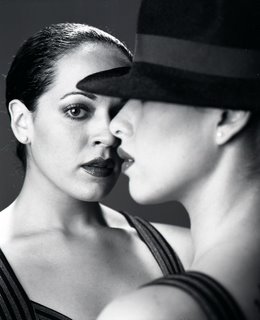
While driving home on Thursday night I was exhausted after having taught photography to 16 eager students from 7 to 10. I turnen on the radio and Leonard Cohen was being interviewed ( I will not mention the person doing the interview as this person when not interviewing is usually promoting the show). Who says the CBC does not have commercials?


Cohen explained his relationship with the many women of his life and was comfortable in describing women as being beautiful and how they have inspired him through the years. Without having to go into political correctness or evade the issue he managed to set me straight that a beautiful woman is all you need as justification for writing a song or in my case taking a picture or using the woman’s image to illustrate a blog. In today’s blog I am displaying the faces of two beautiful Argentine sisters.
I am not one of those conventional men who gets excited with the sight of two women together, be they clothed or unclothed. The sight of two women dancing is not particularly my cup of tea. But the parameters change when you have two sisters, the Lorenzo siters, in your studio dancing the Argentine tango and every move, every gesture; every whispered secret, becomes a marvel of intimacy and eroticism.
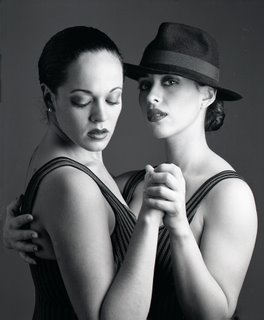

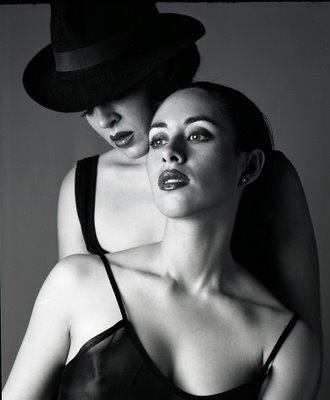
Addendum: Blogger is back in service (Sunday afternoon) so I have insterted the pictures in the normal way.
Cocktails For Three & Bananas At The Dinner Table
Thursday, April 16, 2009
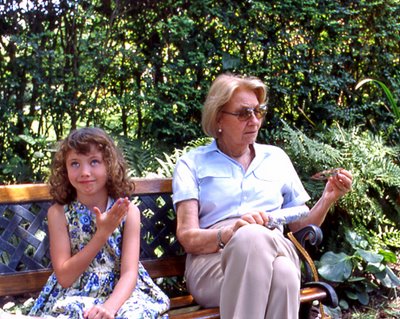
Inesita O’Reilly Kuker is 85. She is my first cousin and also my godmother. The reason she is my godmother is that her mother Ines (my father’s oldest sister) who wanted to be my godmother was not a Roman Catholic. To have such a person as a godmother was frowned upon by the conservative Roman Catholic society of Argentina in 1942 (the year of my birth). Ines’ daughter Ines (Inesita) became my de-facto godmother. She had married Jorge O’Reilly that same year and had converted to her husband’s Catholicism in order to have a church wedding. I never found out if I had a godfather. My mother told me often that I had been given my middle name of Alejandro because of Ines’ second husband Alejandro Ariosa.
In my late 40s and early 50s garden birthday parties, Inesita (very beautiful) would appear with her then three children (she subsequently had another). The eldest, Georgito was a holy terror who bullied my friends. He had this crazy grin on his face that usually indicated he was about to sock you.
In 1965 I showed up at Inesita’s palatial home in Belgrano in my new Argentine Navy conscript uniform. Inesita had been a young widow when her eldest Georgito had been 14 in 1957. Georgito was given a special dispensation by the Argentine schoolboard to abandon school and to work as a messenger boy. By 1965 she had married a wonderful widower (with four daughters) called Dolfi Kuker who was of German extraction and was mayor of Buenos Aires for a short period of time.
When I rang the bell I instantly felt the presence of spying eyes. I was shown in and everybody stared. I had last seen them at my last birthday party, one in August of 1954. I was shown to the dining room where I saw the longest dining room table I have ever seen in my life. If you count Inesita and her husband, his sister Lala, his four daughters, her four children (three boys and one girl) and then accommodated for the girl friends and boyfriends you can understand the size of the table. My lovely red-haired first cousin, Elizabeth Blew was there, too. I faintly remember that my place setting had silverware in the double digits. When we began to eat I noticed that nobody did anything. They were all staring at me wondering what uncouth table manners the relative from far away Mexico was going to reveal.
I must have passed muster as soon, everybody was happily eating. Inesita with her Queen’s English ( I argue that it is the other way around as Inesita is older than Elizabeth II) asked me, “Alexander, what have you been up to? ” I was so startled by it all and by the presence of my beautiful first cousin Elizabeth that I don’t remember a thing. I have even forgotten that Elizabeth was there until recently she told me, “Alexander, I was there as I dined there every Tuesday and it was a Tuesday.” After a few dinners in Belgrano I was comfortable enough to notice the details. I watched one of Dolfi’s daughters Heidi peal an orange on her plate with a fork and knife. I watched her do the same with a banana.
Through all these years I have had an increasing affection for my godmother. I admire her beauty, her intelligence, her sense of humour and her ability to remember the names of her 14 grandchildren and 23 great-grandchildren.
In 2004 I traveled with Rosemary and Rebecca and re-connected with Inesita. Rebecca was impressed by her English and her perfect high-tea table that she offered us one day. I had brought Inesita books in English. Books in English are expensive and hard to get in Buenos Aires. Currently a pocket book will cost $30. Inesita appreciated the books.
The problem now is that Inesita’s eyes are failing her because of a recent fall that resulted in a blood clot in one of her eyes. I know how she misses reading in English. Like many members of my family (my mother would have called them “gente fina como nosotros” or people with good taste like us) Inesita doesn’t read just any book. She likes authors like Susan Howatch and P.D. James.
I may have found a solution yesterday where I noticed a promotion at Chapters. You could buy two audio books for $10 (complete and not abridged) by such good authors as Philip Roth and Umberto Eco.
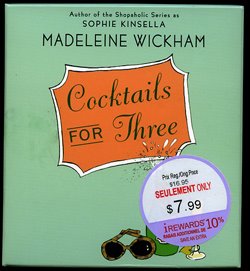
The hitch is mailing anything to Argentina. My package can be pilfered or stolen. The solution, I believe is what I ended up doing. I copied the four CD's of Madeleine Wickham's Cocktail for Three and sent them in an innocuous envelope marked family photo CDs, no commercial value. I think it will get delivered. If it isn't I can try again. My friend Mark Budgen always suggests DHL Couriers. "The reason they are more expensive than Fedex," he says, " is that the price includes the bribe."
I Skyped Inesita today and told her I had mailed her book. She is all excited. I have no way of knowing how long it will take. I took the opportunity to get a few more facts like the exact number of her grandchildren. And then on a lark I told her how astounded I had been to see Heidi peeling a banana with a fork and knife. Inesita's answer made my day, "You don't eat bananas at the table like monkeys."
I must not have ever eaten a banana at the dinner table in her Belgrano mansion. Had I, I would have certainly known.
A Policeman's Dessert Pleases Rosemary
Wednesday, April 15, 2009
Mermelada.(Del port. marmelada).
1. f. Conserva de membrillos o de otras frutas, con miel o azúcar.
Membrillo. (Del lat. melimēlum, manzana dulce, y este del gr. μελίμηλον).
Ate.
1. m. Méx. Pasta dulce o carne hecha de frutas como membrillo, durazno, guayaba, etc.
Diccionario de la Real Academia Española (RAE).
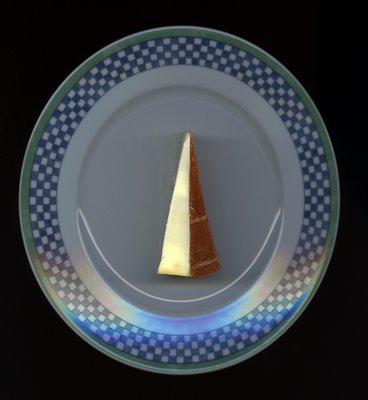
We know that the English love their marmalade and that the best is made from Seville oranges that are brought by ship from Spain. In English marmalade is always made from oranges and not as frequently from lemons.
In Spanish it all changes. Mermelada is jam made from any fruit and jelly is jalea. The Portuguese beg to differ since for them marmelada is quince paste, period and forget oranges and any other fruit! The story is that Greeks and the Romans brought quince plants (from the rose family) from the middle east to Spain. Portugal did not exist at that time so the argument between the Spaniards and the Portuguese as to who invented jellied quince jam is no contest. Quince is high in pectin and with equal amounts of sugar (or honey) and cooked quince the result is a conserva or preserve that does not neet to be refrigerated. Wherever the Spaniards and the Portuguese went in their travels of exploration to the New World or around Africa to the East they brought their quince jam recipe. Another favourite is to make it from guayaba (guavas in English). In Mexico they make ate (as the Mexicans call jellied fruit) not only from membrillo (quince) guayaba but also from apples, strawberries and mangoes (my personal favourite). Mexicans insist that to make proper ate de membrillo one must use a copper pot. I have not been able to corroborate this yet.
Only Argentines seem to make a dulce from sweet potato or yam. It's called dulce de batata. It is extremely sweet and only an Argentine can possibly stomach it. Another variation dulce de batata con chocolate where the sweet potato is layered with jellied chocolate is even sweeter!
In brief dulce de membrillo (Spain, Argentina and most of South America) is called ate de membrillo in Mexico. In most of these countries the sweet is served as a dessert with some sort of white cheese. A little finger sandwich is made with the cheese and the quince paste. It is almost a ritual dessert in Argentina. It is called el postre de vigilante or the policeman's dessert because he (I have yet to see an Argentine policewoman on a beat in Buenos Aires) because the cop can eat it parado or standing up and he can wolf it down if he has to leave for an emergency. In Argentina the cheese of choice is called queso fresco which is a cow's milk cheese that is not aged. In Mexico they like to use Queso Chihuahua which is similar to a mild white cheddar.
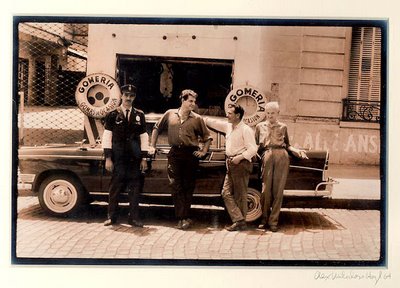
For reasons that escape me Rosemary likes "dulce" (you need not add the words membrillo and cheese, it is understood!) as if she were an Argentine. She was out to a Master Gardener meeting last night and when she returned I surprised her with her favourite dessert. My grandmother, Lolita, liked her dulce and cheese dunked into her morning coffee or her afternoon hot chocolate.
Two Aircraft Carriers Into A Sunset
Tuesday, April 14, 2009

HMCS Warrior: Colossus class light carrier in service in the Royal Canadian Navy from 1946 to 1948; return to Royal Navy and sold to Argentine Navy as ARA Independencia (V-1)
ARA Independencia (V-1): Colossus class light carrier in service from 1959 to 1969; scrapped 1971
NAeL Minas Gerais: Colossus class carrier in service from 1960 to 2001. Retired.
In 1958 the Argentine Navy purchased an aircraft carrier from the Dutch. The small carrier had been around the block. It was HMCS Warrior which had been in service with the Canadian Navy (see above) until 1948. The Royal Navy had then sold it and a sister ship to the Dutch Navy. In the 60s, as now, Argentina and Brazil were out to prove who the military power in the Southern Hemisphere was. As soon as the Argentine Navy had its carrier the Brazilians could not be left behind. They wanted one just like the Argentine one so they approached the Dutch Navy and purchased a Colossus class carrier and named it the Minas Gerais (look on the left side of the first picture or below left). The Brazilians had a problem.

When the Argentines bought their carrier they immediately created a naval air arm. They then made arrangements to get Douglas Skyhawks which were aging but still excellent carrier borne jets. The Brazilians had no naval air arm. Their navy argued that the planes on the carrier would be their jurisdiction. The Brazilian Air Force pointed out that since the navy had no airplanes they (the Brazilian Air Force) would have command of the planes on the carrier. They argued back for years. In 1966 when I took this picture the argument was still in full force and the ship was rusting on Guanabara Bay off Rio de Janeiro.

Not having any planes did not stop the Brazilians from showing off their purchase. I was in the Argentine Navy in 1965 when the Brazilians decided to make a port of call with the Minas Gerais in Buenos Aires. I will never know the exact truth. Perhaps the Argentine Rivert Plate pilots gave the Brazilians the wrong information. The carrier ran aground coming into Buenos Aires and leaving it. The River Plate has to be constantly dredged as silt quickly settles on the access channels for sea-going vessels. It was most embarrasing for the Brazilian Navy. I remember that we made fun of the Brazilian's uniforms particularly those of the officers. They had huge 19th century style epaulettes and the colour combinations were jaring.
Shortly after I remember going to a Santos of Brazil soccer match with the Argentine side, River Plate. Santos dressed in dazzling white uniforms (in impeccable taste) soundly defeated the Argentines in their own turf. Santos had Pelé when he was playing in his prime. One of the only perks of being in the Argentine Navy was that I could go to football matches for free if I wore my uniform. It was during this match that Pelé was met by a couple of overly enthusiastic Argentine defenders. Pelé kicked the ball forward (with his back heel) high into the air. He jumped over one of the defenders and ran around the other and when the ball came down he was alone with the goal in front of him. He deftly, and gently, tapped the ball in for the best goal I have ever seen. In retrospect I think that Pelé somehow made ammends for his navy's poor seamanship.

During my voyage from Buenos Aires to Veracruz in the Argentine Merchant Navy Victory Ship Río Aguapey I had the run of the ship as the only passenger. After my stint as a conscript the Argentine Navy I had swung a repatriation passage to Mexico (where I lived) from a friendly Argentine admiral. Besides reading Spengler I decided to photograph every sunset we had. Not too many of those sunsets have survived storage in my files all these years (since 196) but here are three off the coast of Brazil that did.
In 1985 I saw Terry Gilliam's Brazil at the Park on Cambie with science fiction writer William Gibson. I saw the film again today. After the film I went into my files and looked for Brazil. I found the sunsets.
One of my favourite books of all time is Lawrence Norfolk's The Pope's Rhinoceros (1996) which is a novel on how both the Portuguese and the Spaniards attempted to bribe Pope Leo X with a mysterious and yet unseen rhinoceros so that he would divide the "New World" to their favour. It would seem that somehow the Spaniards lost out.
 The Treaty of Tordesillas, which had been ratified in 1494 by Pope Alexander VI, with its line of demarcation gave the Eastern bulge of South America (a future Brazil) to the Portuguese. The Spaniards had lobbied and kept lobbying to change this but the country became a Portuguese-speaking Brazil. It is just as strange, as that rusting aircraft carrier, that an African/Indian mammal, the rhino, would affect the future of the New World.
The Treaty of Tordesillas, which had been ratified in 1494 by Pope Alexander VI, with its line of demarcation gave the Eastern bulge of South America (a future Brazil) to the Portuguese. The Spaniards had lobbied and kept lobbying to change this but the country became a Portuguese-speaking Brazil. It is just as strange, as that rusting aircraft carrier, that an African/Indian mammal, the rhino, would affect the future of the New World.
Onward Christian Soldiers - A Confirmation
Monday, April 13, 2009
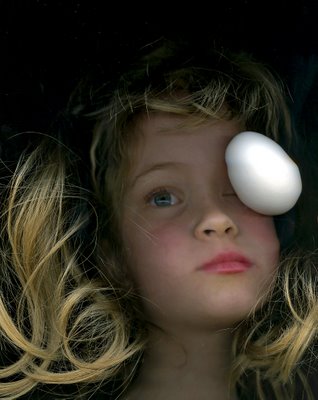
As a little boy I often saw my grandmother saying her Holy Rosary in silence. I could discern the syllables of the padre nuestro and the ave marías on her lips. This was the reverent side of religion of which my grandmother taught me a lot. But there was an irreverent, almost comical, side of her Catholicism that even as a small boy I found funny. When my mother or grandmother lost some precious or not so precious object they would make a bargain with St Anthony of Padua. If this saint, the patron saint of lost objects, would come through they would then pay so much and leave said some at his box at the local church. But he would get nothing if the object remained lost.
In the general and then predictable order of my Catholic life, confirmation was the second sacrament I received after baptism. My grandmother made it plain that this sacrament made it a duty for me to be a defender of the faith. I enquired about that heroic tune that my father and I would sing in bed, Onward Christian Soldiers, and she told me that this was not really what confirmation was about. “You have to be able to explain your religion to strangers, who may ask, defend its tenets verbally and by example. Only then will you be a proper Christian soldier. At the time I found this most boring as singing Onward Christian Soldiers and My Bonny Lies Over the Ocean was much more fun. The prospect of hitting some uncouth heathen on the head with my wooden sword and forcibly entering them into the bosom of the Mother Church was much more exciting.
Four years at a Catholic boarding school in Texas, St Edward’s High School and four years of excellent and detailed instruction of Catholic doctrine (courtesy of Brother Edwin Reggio, C.S.C) complete with forays into Aristotle, Augustine and Aquinas made me truly a Catholic soldier that my grandmother was proud of.
It all unraveled (or at least in hindsight it seems to have done so then) sometime around mid April 1966 in the Buenos Aires zoo. The April 8 Time Magazine had on its cover the shocking question, Is God dead? I was dressed in my Argentine Navy whites and I was sitting by the lions reading my copy of Time. In those days I read the magazine every week and only missed a few that the Argentine Junta deemed insulting to their benign rule.

It was in the late 60s when talking to my mother that I seriously began to doubt some of my beliefs. My mother suffered from an advance case of vertigo Ménière. Besides a constant ringing in her ears that was making her deaf she had terrible dizzy spells that had the whole world moving under her and she would hold on to her bed for dear life. By then my mother was in her late 50s. One day, one I will never forget, she told me, “I no longer believe in a God that cares. I believe that my prayers a wasted on a being who created us and then left us to our devices. I believe in a remote and selfish God.”
Years before around 1963 my grandmother and I had been against her being wooed by a pleasant but balding man, a Mr. Medrano, we nicknamed “Poco Pelo” or Little Hair. We did everything possible to scuttle the relationship until my mother finally gave up. I look back at that event in my life with deep shame particularly when I remember what my mother told me right after her concept of her selfish God.
“Alex, I am 57, I am still a sexual being in spite of my Ménière’s. I have lived in loneliness since I left your father in 1953. I want more of my life.” I was speechless and had no comforting words. She left me in depression when she added, "I have lost my faith in the power of prayer."
Since those days I have dabbled in the works of Spinoza, Hegel and Spengler. The Time article on God pointed me in the direction of Nietzsche. I have found some comfort in the notions of non existence so calmly explained by Epicurus.
As I lay in bed last night after our successful Easter dinner with our guests, the Stewarts, I asked Rosemary, “We have been married for 41 years. How has all that time passed without us really knowing? Where are we going?” Rosemary was silent. I was troubled because of a 1927 silent film I had seen a few hours before.
Last night I finally saw in its entirety, Cecil B. D. Mille’s The King of Kings. After filtering out of my system some of the over dramatic acting I enjoyed the beautiful camera work. I instantly dismissed D. Mille’s “Christ trick” of using an ever present backlight and a soft focus filter. These two factors when combined with Christ’s (H.B. Warner) white toga made him fluoresce like magic. Add to this little fluorescent-white trained doves and the effect was rather campy. This film is well worth watching for two performances. One is by Austrian born Joseph Schildkraut (Judas) and the other by Victor Varconi as Pontius Pilate. Schildkraut in later years made wonderful films (The Man with the Iron Mask) where he played a hateful villain. In The King of Kings he played an uncommonly handsome and complex Judas to matinee idol perfection. Varconi, as Pilate without the advantage of sound, was a Pilate who truly knew this man, this Christ was innocent. The path between him trying to save Christ to his eventual washing of his hands is a silent tour de force.
The film left me empty. It was like watching a magician when I was 8 and believing that what I was watching was pure magic. The magician was truly swallowing that string of Gillette blades. Many years later I marvelled at films that showed pianos playing without the help of human hands. I could never get the thrill of watching the keyboard of my Smith Corona PWP-40 magically type out my letter after I had pressed, “print.”
As my St Ed’s High School reunion looms in June I am thinking of going a day early. I want to sit with Brother Edwin and chat. Do I dare ask him about his beliefs? He gave me all the intellectual tools to make me a perfect soldier of Christ. Or should I just let those days of soft focus magic remain and just soldier on as I am now?
Fried Eggs, Deviled Eggs, Scrambled Eggs & Rosemary's Yorkshire Pudding
Sunday, April 12, 2009
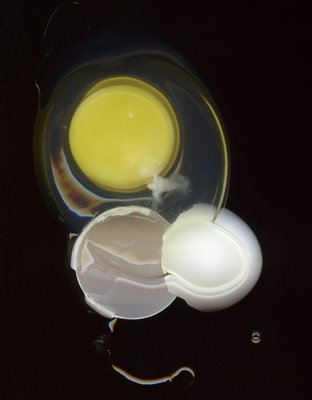
It was sometime around 8 years ago when I finally gave up trying to urge Rosemary to cook meals for us. All my constant nagging caused was ill feeling. I could not use the male argument that as the breadwinner she should cook for me. Her breadwinning was every much as important as mine. I am a freelancer so my monthly income has always been uncertain. Rosemary has always had a good and steady salary.
I knew something was up when we married 41 years ago and Rosemary had asserted, “I will never scrub floors for you.” I had plenty of advance preparation for this sort of treatment, from females, from my own mother. I may have been around 11 when I complained that she had broken my fried eggs. I told her, “I refuse to eat fried eggs that don’t have pristine yolks.” I remember pushing my plate away. My mother said, most calmly, “Hijo ya es hora de que sepas freir un huevo.” (Son it is time that you learn to fry your own egg.)
I learned to fry eggs. I don’t like to fry them in very hot grease. I want them to look poached. I scramble them without mixing the whites and the yolks too much. And I never overcook them. Unfortunately I like to eat them with catsup as we were forced into this culinary depravity back in the middle 50s at St. Ed’s where the frugal Brothers of the Holy Cross had purchased tons of Korean surplus powdered eggs. Catsup was the only way to make them edible. I learned to make mean cheese omelets and I can surprise many with my French shirred eggs. I use Gruyere cheese, cream and hot paprika. Summer in the garden is never complete with my deviled eggs. I make mayonnaise from scratch for them and I use a generous amount of Keen’s Dry Mustard. After all it is the hot mustard that makes a deviled egg a genuine deviled egg. But my specialty is the cheese soufflé. My secret is to always add an extra two or three egg whites into my mixture.
Rosemary is the expert who buys the groceries. She knows her prices and knows how to economize. She has a special talent for choosing ripe mangoes and sweet grapes. She is no Argentine but the meat she buys for me to cook is always the best.
We are looking forward to our Easter dinner. We have invited the Stewarts (Hilary, husband Bruce and our beloved granddaughters Lauren and Rebecca). I am cooking the roast beef ( a Rosemary bought sirloin tip). I partially brown it on the outside on the barbecue before I bring it in and finish it in the oven. But the most popular dinner item (especially with Hilary) is Rosemary’s Yorkshire pudding. When Rosemary is inclined to cook she cooks very well. It is Easter, after all, so I might also prepare a few of my deviled eggs!
Rosemary had the last word with eggs. She announced we were having a merengue for dessert. She uses whipped cream and strawberries.
The Lilies Of The Field
Saturday, April 11, 2009

The Eleysian fields were the home of the blessed in the afterlife of the Greeks. These fields were carpeted with a type of flower the Greeks called asphodelos. Some scholars believe that it is the origin of the English daffodil. For me what is interesting is that the botanical name for the daffodil is Narcissus. The story is that when Narcissus drowned while gazing at his beautiful countenance, daffodils grew near the spot. Certainly not in the water as daffodils hate to be waterlogged. The daffodil is supposed to have a powerful narcotic. Both narcotic and narcissus have the same prefix root.
Yesterday I tried to identify the origin of the biblical term “the lilies of the field.” In my Catholic The New American Bible ( The Rembrandt Edition, beautifully illustrated with Rembrandt’s paintings and sketches) I found this in Matthew 6: 28 – 34:
As for clothes why be concerned? Learn a lesson from the way the wild flowers grow. They do not work; they do not spin. Yet I assure you, not even Solomon in all his splendor was arrayed like one of these. If God can clothe in such splendor the grass of the field, which blooms today and is thrown on the fire tomorrow, will he not provide much more for you, O weak in faith!

My father’s American Society King James Bible is more forthcoming:
And why take ye thought for rainment? Consider the lilies of the field, how they grow; they toil not, neither do they spin: And yet I say unto you, That even Solomon in all his glory was not arrayed like one of these. Wherefore, if God so clothe the grass of the field, which to-day is, and tomorrow is cast into the oven, shall he not much more clothe you, O ye of little faith?

What is interesting is that both bibles mention the grass. We who are botanically literate know that corn, wheat, barley and most other grains are grasses in which man selected the plants that had the larger seeds or bred it for grain size.
We know the story of the angel “flying over” over the homes of the Hebrews in Egypt in reference to the Passover. The Hebrews were instructed to mark the doorposts of their homes with the blood of a spring lamb and, upon seeing this, the spirit of the Lord passed over these homes, hence the term "passover".
I found another relevant link. Pascua is Spanish for Easter. The origin of the word is from the Latin pastus or grass. My RAE (Real Academia Española) dictionary further explains that grass was used to break the fast. The Jews use unleavened bread (made from glorified grass?) during the Passover. Furthermore the Jewish feast of Passover is pascua in Spanish.

It is higher mathematics to try to explain to anybody as to how the Catholic Church determines when Easter falls each year. It is far easier to understand that the first Easter happened to fall in Passover. It was because Christ and His disciples had their last supper (not because they would not again break bread with him) but simply because it was the last supper before the Passover began. This was explained to me so many years ago by Brother Edwin Reggio CSC and I like the neatness and the order of that initial synchronicity.
As for the Easter lilies of the field it is mostly a marketing ploy as the original Easter lily is Lilium longiflorum, native to the Ryukyu Islands of southern Japan. The only lily-like plant that grows in the Holy Land is the narcissus. Thus I can safely illustrate this blog with a couple of very nice daffodils from our garden. Rosemary planted these around the early 90s in our outside back lane garden. This is the first time I have ever stopped to smell them. At first I thought they smelled like my kitchen spice drawer. Then I pulled spices out, one by one, and it was mace that most resembled the smell of our daffodils.
Sky Blue Over Rust - High Noon In Detroit
Friday, April 10, 2009
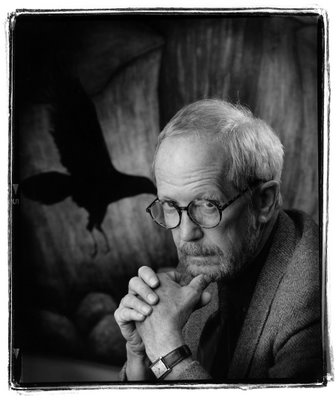
Hunter was in the blue Plymouth standing at the hospital entrance. He turned the key as Raymond got in…held the key, his foot pressing the accelerator, but the car wouldn’t start. It gave them an eager, relentless, annoying sound, as though it was trying, but the engine refused to fire… Hunter said, “Fucking car…”…"Drive this piece of shit, you know why they’re fucking going out of business.” The engine caught and Hunter said, “I don’t believe it.”
City Primeval – High Noon in Detroit, Elmore Leonard, 1980
Clement bught a ten-shot .22 Ruger automatic rifle, a regular $87.50 value for $69.95, and a box of .22 longs at K-mart in the Tel-Twelve Mall. He went over to the typewriter counter and asked the girl if he could try one. She said sure and gave him a sheet of notepaper. Clement pecked away for a minute, using his index fingers, pulled the notebook paper out of the Smith-Corona and took it with him. He saw a black cowboy hat he liked, put it on and walked out with it…down a block to Red Bowers Chevrolet where Sandy Stanton was wandering around the used car lot in her high-heel boots and tight jeans.
She saw him coming wit the black hat on, carrying the long cardboard box sticking out of the K-mart sack and said, “Oh my Lord, what have you got now?”
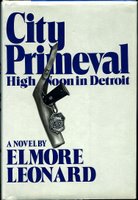
He told her it was a surprise and Sandy brightened. “For me?” Clement said not, for somebody else. He looked around at the rows of “Fall Clean-up Specials” and asked her is she’d picked one out. Sandy led him to a Pontiac Firebird with a big air scoop and the hood flamed in red and gold, sunlight flashing on the windshield.
“Isn’t it a honey? Looks like it eats other cars right up.” Clement said, “Sugar, I told you I want a regular car. I ain’t gonna street race, I ain’t gonna hang out at the Big Boy; I just need me some wheels in your name till things get a little better. Now here’s seven one-hundred-dollar bills, all the grocery money till we get some more. You buy a nice car and pick me up over there – if I can make it across Telegraph without getting killed – where you see that sign? Ramada Inn? I’ll be there having a cocktail.”

Sandy got him a ’76 Mercury Montego, sky blue over rust, with only forty thousand miles on it for six-fifty plus tax and Clement said, “Now you’re talking.”
A boy who was born on an oil lease and traveled in the beds of pickup trucks till he was twelve years old would be likely to have dreams of Mark VIs and Eldorados. Not Clement. He had driven, had in his possession for varying periods of time in his life, an estimated 268 automobiles, all makes and models, counting the used ’56 Chevy four-barrel he’d bought when he was seventeen and the used TR-3 he’d bought one time when he was feeling sporty; all the rest he stole. Clement said cars were to get you from here to there or a way of picking up spending money. If you wanted to impress somebody, open their eyes, shit, stick a nickel-plate .45 in their mouth and ear back the hammer.
City Primeval – High Noon in Detroit, Elmore Leonard, 1980
Thursday, April 09, 2009

When my Mexican painter friend David Merino visited me in the garden one long ago summer afternoon he was suddenly hit by sun from behind. I told him not to move and brought my large flash from the inside and adjusted it with a narrow grid. “You look like Moses coming down from the mountain after having seen God.” His expression was so out of character as Merino is so quiet spoken that he speaks in whispers. He is gentle. He paints with the ochres, browns, yellows and reds of his native Mexico. They are the colours of the mountains in the dry season. They are colours that I miss in Vancouver with all those greens, blues and grays.
But the picture also reminds me of a short story by Julio Cortazar called La Noche Boca Arriba (The Night Face Up). This is the ending of the story in my loose translation:
But he could smell death, and when he opened his eyes he saw the bloody figure of the sacrificing priest who came towards him with a stone knife in hand. He managed to close his eyelids again, although he now knew he was not going to wake up. He was awake. That wonderful dream had been another, absurd as all dreams. A dream in which he had been moving through strange avenues of an astounding city, with red lights and green lights which burned without smoke. He had been on an enormous metal insect that had buzzed below and between his legs. In the infinite lie of the story they had also raised him from the floor, and also someone had approached with a knife in hand while he was lying with his face up, to him face up with his eyes closed among the bonfires.

Down in Japanese town, you have to watch were you step. As you stand in a corner store at Powell and Dunlevy, waiting to buy a pack of cigarettes, a guy in navy blue ey bags and pinstripe nose will engage you in a one-sided conversation on the hopelessness of trying to get a job if you have been in the "joint" for the past six months. You offer him a couple of smokes, holding the door open as a long-haired fellow about 35 and legless, wheels his way past. Cheryl Ladd, peering up from the glossy cover of TV and Movie Star Parade, smiles cleanly unaware of this side of the tracks.

Across the street, the amateurishly drawn green-and-orange silhouette of a woman beckons you through the Marr hotel's butcher block door. Inside, in the dark, Kiss's thunderous heavy metal music drowns out your depressed maunderings. In the center of the room, swathed in red and blue stage lights, a tall, slim woman with soft brown hair down to her thighs, sways and sashays about the stage. Her face: the fragile cheekbones of a high fashion model. Her expression: serene, with the frail ethereal melancholia that brings lumps to the throats of strong men.
You fumble for a seat, and a heavy pint glass of cold, frothing beer is set in front of you. Fishing a deuce from your pocket and waving the waiter out of your field of vision, you sip through the frosty foam, all thoughts of the ugliness beyond these walls a vaguely remembered chimera. You relax, and bless the day you were born.
Les Wiseman, Vancouver Magazine, March 1982

All I can add to the above is that Samantha Rae usually danced ever so slowly and she would look at you straight in the face with that unfathomable almost-smile of hers. And she made Roxy Music's Avalon all her own.


There is an indescribable loneliness in not being able to find a kindred artistic spirit. At one time I could have called any number of people and asked them, “Let’s go and take some pictures.” Or I could count on my Argentine friends (now sadly gone) Nora Patrich and Juan Manuel Sanchez to participate in joint artistic projects.

When the urge gets unbearable, I break down and pick up a camera. I go out to take pictures. My swivel lens panoramic Noblex is a complex instrument. Because I don’t use it with regularity I forget the whole process of correctly loading it with film. The pictures here which I took on a cold winter morning in February at the CN Train Station are the product of such errors. One of the pictures is not the full sweep while the other shows a truncation caused by a flattening roller that was underneath as opposed to over the film.
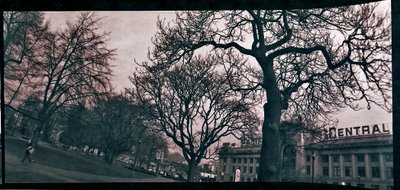
I like the look. In photography it is crucial to know how an error was made so that one can then repeat it with all creative deliberation.
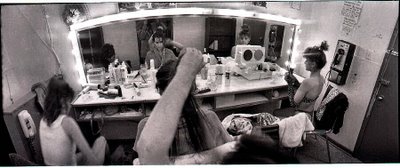
A rare arts assignment to photograph baritone Greer Grimsley who is to appear in the Vancouver Opera’s production of Strauss’ Salome had me thinking. I am to photograph the man in a special effects studio where they are going to make a life mask from which they will then model St John the Baptist’s ( Jokanaan in the opera) severed head. It would seem that since time immemorial man (as in politically incorrect “the male of the species”) has been ready to give up just about anything to see a woman undraped.
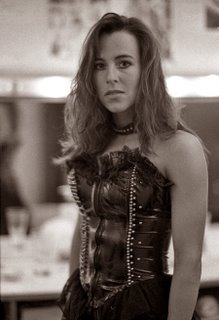
That the current play by the Electric Theatre Company and presented by the Vancouver Playhouse Theatre Company, Studies in Motion – The Hauntings of Eadweard Muybridge has not created any obvious stir of shock or at least a stream of salacious blogs or letters to the editor (and it is a terrific play which I have seen three times) has something to say about the current state of affairs between man (the male of the species) and his forsaking of the enjoyment of the undraped female form. The play has a cast of 11 (about 60% men) and all undrape fully. If you sit on the front row you can dispense with the binoculars.

If anybody had told anybody in Vancouver that our fair city would one day not be known for its excellent strippers, its squeaky clean strip bars and that by 2009 there would only be three strip bars left within city limits they would have not been believed. But that is a fact that strip bars are all but gone and the B-lineup St Regis is now a luxury boutique hotel! Who would have known? I don’t frequent the strip bars. It is not really my sudden shame at liking something that is a bit frowned upon by civilized society.

It is more about being 67 and I am losing interest. The idea of a good book, a large mug of tea and bed in the evening is far more an attractive idea than lounging at a bar looking at women take their clothes off. But what do all those young men do these days? Watch pornography on their computers?
It will always be the same that things were better then than now. Punk music then was real punk music. Now it is derivative and imitation punk music. Strippers then danced. Strippers now take their clothes off, period.
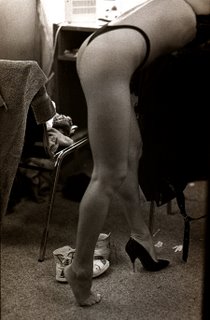
I am sure that I am wrong on all counts and there must be many dancers of note. I know of one who was a ballet dancer before she switched to nude pole dancing. When I last saw her a couple of years ago she was the best pole dancer in the province.
Perhaps my lack of excitement is that the age difference between dancers and this old man becomes a gulf. It was in the late 79s that Vancouver Magazine assigned me to take pictures of women wearing eyewear from boutique frame stores. The art director, Rick Staehling asked me, “The models you used are most unusual. Where did you get them?” I fudged the answer as I did not have the heart to tell him that I had picked my favourite exotic dancers and I had enjoyed giving them their checks for modeling with their clothes all on.

It was at Tony Ricci’s Marble Arch that I could walk in and sit by the bar and talk in Spanish to Jorge the barman. He would offer free drinks but I always had soda water. I felt like Humphrey Bogart walking into a bar. Jorge and Tony made me feel special.
But it was at Tony’s Number 5 Orange in May 1990 that I felt king for a day. I had been assigned by Equity Magazine to take pictures for an article called Sex Sells. Having been convinced through the years by Malcolm Parry to seek the privileged view in all things I knew what I wanted. Parry defines the privileged view more like what you see when you look down as opposed to what you see looking up.
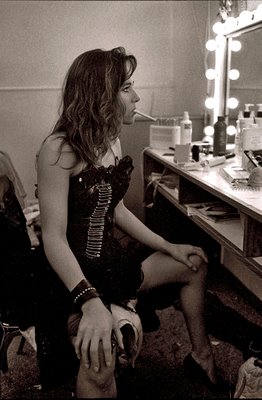
Anybody (of the legal age) can enter a strip club. At the Number 5 Orange Street the tradition has been to see the fully dressed woman step down to the dance floor on a lit Lucite ladder that connects to the roof. As Mac would have said, “Anybody can watch her come down. But to be up there and watch her go down, that would be special.”
I asked Tony if I could take pictures in the dressing room. He smiled, “Anything you want, Alex and I’ll have Daniele accompany you up to make it easier for you.” Daniele was simply one of the most gorgeous women I ever met in my life. Up we went.
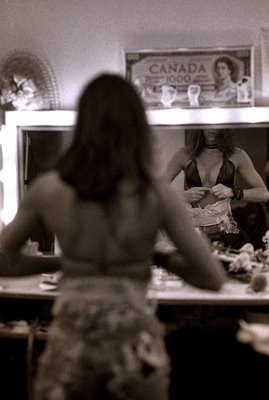
I decided I would photograph the whole routine of one dancer. I was in luck because Portia Winters was up there so I took many pictures of the process. I learned one interesting fact about strip bars of those years. There were traveling male hairdressers who did hair for the dancers. One was there to fix up Portia. Remembering Mac Parry I managed to photograph Portia going down the golden stairs.
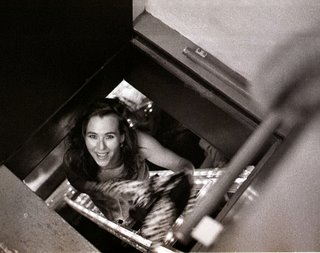
The best moment of the day came when I finished and Daniele(Kimberlly) and I went down to the bar. Daniele had well toned arms and helped me with my heavy lights. My friend Sean Rossiter happened to be in the bar and when he saw me and my assistant and, where we were coming from he just about collapsed with wonder. He has never allowed me to forget the day. Not that I would.
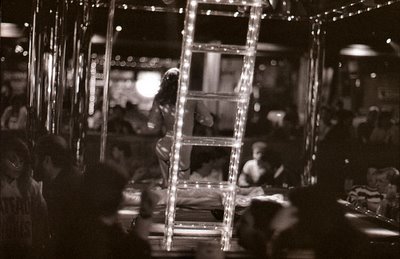
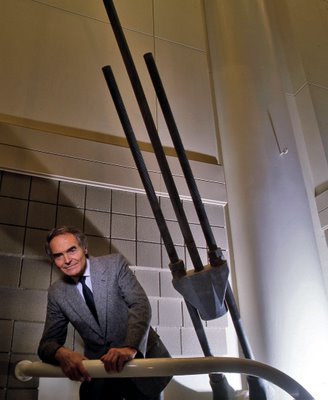
Eberhard Heinrich Zeidler O.C., O.Ont. ( January 11, 1926 in Germany) is a Canadian architect. He studied at the Bauhaus, Weimar, Germany, and the Technische Hochschule, Karlsruhe, Germany. Zeidler immigrated to Canada in 1951 and formed his first partnership with Blackwell and Craig of Peterborough, Ontario. He later went on to create a new firm, Zeidler Roberts Partnership/Architects in Toronto, and offices in Washington, London, Berlin, and West Palm Beach, Florida.
I met up with architect Eberhard Heinrich Zeidler sometime in 1986 when I went to photograph him for Equity Magazine. I was accompanied by editor Harvey Southam who told me, "You will like this man. He will remind you of Vernher von Braun. He is crazy about these tension wires that keep the roof of his new Canada Place up." I remember that lighting the man was a bit of a nightmare but he was pleasant and patient. Since 1986 I think that Zeidler's Canada Place has served us well. The "sails" became one of the symbols of our city. I believe that there is nothing iconic about the new Vancouver Convention Centre billed as the largest waterfront convention centre in Canada.
As I look back (people tell me that this has become an obsession) it seems to me that if one could transport the Vancouver Museum and Planetarium via the Star Treck transporter to the waterfront it would become a Vancouver icon with our sails. The new convention centre with its large green roof will add nothing memorable to our waterfront. They should have contacted Eb Zeidler. He would have come up with something that would have put us on the map. The new convention centre will just cement the idea abroad that we Canadians are boring.

In the early 70s I was a high school teacher at a private school for wealthy American and other foreign kids in Mexico City. I was idealistic and I had teaching in my blood. Both my mother and grandmother had been teachers. This seemed to be my career, too. My bible was Neil Postman and Charles Weintgartner’s Teaching as a Subversive Activity (1969). In many ways I was at odds with the school principal who was a member of the Daughters of the American Revolution and she was enamored with Richard Nixon.
One day my students, ninth graders, were vocally complaining about the stupidity of the coming student council elections. Their complaints sounded much like the modern beef about politicians these days. It was about promises being made and never carried out and how the student council really had no power as democracy was not evident in a school ruled by an irond hand principal. In spite of everything that I was accused of having done, including the corruption of youth, much later, all I told my students was, “If you don’t like the methods being used for the election of student council officers, change the system. Look up how governments were changed in my country of Argentina.” My ninth graders made the motion of participating in the election proceedings and some ran for the only office available for ninth graders, the office of treasurer. But I knew something was up as they would whisper in corners and stare in my direction when I passed them by the school corridors.
The day of the elections we had an assembly. Just before it all started a couple of my students went up to the principal and told her that they had a relevant announcement to make. They went up to the microphone while a few other students surrounded the sound system controls. The two students then explained they were going to read us the school constitution. The principal smiled. After reading it they set it on fire. We all watched in shock as the told us that the constitution was no longer in effect and that the 9th grade had taken over the student council. At that point the school principal was looking in my direction in a most unpleasant way. I remember how funny it was to see all those 12th graders who were running for president and vice president protest. They demanded a return to democracy. To make matters worse for myself I was called into the principal's office and blamed for the coup. She said, "This is not right if you believe in democracy." I was perhaps to young and also too stupid to check myself before I answered, "Only if you believe in it." I was not fired.
A few weeks later I had written on the board the following:
While performing the part that is truly ours, how exhausting it is to be obliged to play a role which is not ours: the person you must really be, in order to fulfill your task, you must not appear to others to be, in order to be allowed by them to fulfill it. How exhausting – but unavoidable, since mankind has laid down once and for all the organized rules of social behaviour.
I asked my class if they could take a guess as to who might have written the above words. The principal suddenly walked into the room unannounced and said, “Probably Fidel Castro.” She had pegged me for a communist.
When I told them all that the writer was no less than Dag Hammarskjöld the ex Secretary General of the United Nations the principal turned around and left the room.
It was somewhat in that spirit of duplicity that I invited Rebecca to attend Studies in Motion – The Hauntings of Eadweard Muybridge tonight. I told Rebecca that her ex-ballet teacher, Andrea Hodge was the movement rehearsal director, that Crystal Pite was the choreographer and that Kim Collier was the director. I told her the story of Eadweard Muybridge but I did not reveal to her that 11 of the 12 actors would take all their clothes off many times during the play.
We watched a bit of Rigoletto at Opera Sushi before going to the Playhouse. The owner chatted with Rebecca and noticed how she has grown. I told him we were out for an evening of theatre.
In the end Rebecca said to me, “I have been entertained tonight. I really liked the play. And like you say, Papi, it is a play I will not forget.” Perhaps we need not see Beau Geste (my personal right of passage from boyhood to that transition into adulthood). Rebecca has just about grown up.

When my Mexican painter friend David Merino visited me in the garden one long ago summer afternoon he was suddenly hit by sun from behind. I told him not to move and brought my large flash from the inside and adjusted it with a narrow grid. “You look like Moses coming down from the mountain after having seen God.” His expression was so out of character as Merino is so quiet spoken that he speaks in whispers. He is gentle. He paints with the ochres, browns, yellows and reds of his native Mexico. They are the colours of the mountains in the dry season. They are colours that I miss in Vancouver with all those greens, blues and grays.
But the picture also reminds me of a short story by Julio Cortazar called La Noche Boca Arriba (The Night Face Up). This is the ending of the story in my loose translation:
But he could smell death, and when he opened his eyes he saw the bloody figure of the sacrificing priest who came towards him with a stone knife in hand. He managed to close his eyelids again, although he now knew he was not going to wake up. He was awake. That wonderful dream had been another, absurd as all dreams. A dream in which he had been moving through strange avenues of an astounding city, with red lights and green lights which burned without smoke. He had been on an enormous metal insect that had buzzed below and between his legs. In the infinite lie of the story they had also raised him from the floor, and also someone had approached with a knife in hand while he was lying with his face up, to him face up with his eyes closed among the bonfires.
Lumps To The Throats Of Strong Men
Wednesday, April 08, 2009

Down in Japanese town, you have to watch were you step. As you stand in a corner store at Powell and Dunlevy, waiting to buy a pack of cigarettes, a guy in navy blue ey bags and pinstripe nose will engage you in a one-sided conversation on the hopelessness of trying to get a job if you have been in the "joint" for the past six months. You offer him a couple of smokes, holding the door open as a long-haired fellow about 35 and legless, wheels his way past. Cheryl Ladd, peering up from the glossy cover of TV and Movie Star Parade, smiles cleanly unaware of this side of the tracks.

Across the street, the amateurishly drawn green-and-orange silhouette of a woman beckons you through the Marr hotel's butcher block door. Inside, in the dark, Kiss's thunderous heavy metal music drowns out your depressed maunderings. In the center of the room, swathed in red and blue stage lights, a tall, slim woman with soft brown hair down to her thighs, sways and sashays about the stage. Her face: the fragile cheekbones of a high fashion model. Her expression: serene, with the frail ethereal melancholia that brings lumps to the throats of strong men.
You fumble for a seat, and a heavy pint glass of cold, frothing beer is set in front of you. Fishing a deuce from your pocket and waving the waiter out of your field of vision, you sip through the frosty foam, all thoughts of the ugliness beyond these walls a vaguely remembered chimera. You relax, and bless the day you were born.
Les Wiseman, Vancouver Magazine, March 1982

All I can add to the above is that Samantha Rae usually danced ever so slowly and she would look at you straight in the face with that unfathomable almost-smile of hers. And she made Roxy Music's Avalon all her own.

An Error As Creative Deliberation
Tuesday, April 07, 2009

There is an indescribable loneliness in not being able to find a kindred artistic spirit. At one time I could have called any number of people and asked them, “Let’s go and take some pictures.” Or I could count on my Argentine friends (now sadly gone) Nora Patrich and Juan Manuel Sanchez to participate in joint artistic projects.

When the urge gets unbearable, I break down and pick up a camera. I go out to take pictures. My swivel lens panoramic Noblex is a complex instrument. Because I don’t use it with regularity I forget the whole process of correctly loading it with film. The pictures here which I took on a cold winter morning in February at the CN Train Station are the product of such errors. One of the pictures is not the full sweep while the other shows a truncation caused by a flattening roller that was underneath as opposed to over the film.

I like the look. In photography it is crucial to know how an error was made so that one can then repeat it with all creative deliberation.
Portia Winters & My Head On A Platter No More
Monday, April 06, 2009

A rare arts assignment to photograph baritone Greer Grimsley who is to appear in the Vancouver Opera’s production of Strauss’ Salome had me thinking. I am to photograph the man in a special effects studio where they are going to make a life mask from which they will then model St John the Baptist’s ( Jokanaan in the opera) severed head. It would seem that since time immemorial man (as in politically incorrect “the male of the species”) has been ready to give up just about anything to see a woman undraped.

That the current play by the Electric Theatre Company and presented by the Vancouver Playhouse Theatre Company, Studies in Motion – The Hauntings of Eadweard Muybridge has not created any obvious stir of shock or at least a stream of salacious blogs or letters to the editor (and it is a terrific play which I have seen three times) has something to say about the current state of affairs between man (the male of the species) and his forsaking of the enjoyment of the undraped female form. The play has a cast of 11 (about 60% men) and all undrape fully. If you sit on the front row you can dispense with the binoculars.

If anybody had told anybody in Vancouver that our fair city would one day not be known for its excellent strippers, its squeaky clean strip bars and that by 2009 there would only be three strip bars left within city limits they would have not been believed. But that is a fact that strip bars are all but gone and the B-lineup St Regis is now a luxury boutique hotel! Who would have known? I don’t frequent the strip bars. It is not really my sudden shame at liking something that is a bit frowned upon by civilized society.

It is more about being 67 and I am losing interest. The idea of a good book, a large mug of tea and bed in the evening is far more an attractive idea than lounging at a bar looking at women take their clothes off. But what do all those young men do these days? Watch pornography on their computers?
It will always be the same that things were better then than now. Punk music then was real punk music. Now it is derivative and imitation punk music. Strippers then danced. Strippers now take their clothes off, period.

I am sure that I am wrong on all counts and there must be many dancers of note. I know of one who was a ballet dancer before she switched to nude pole dancing. When I last saw her a couple of years ago she was the best pole dancer in the province.
Perhaps my lack of excitement is that the age difference between dancers and this old man becomes a gulf. It was in the late 79s that Vancouver Magazine assigned me to take pictures of women wearing eyewear from boutique frame stores. The art director, Rick Staehling asked me, “The models you used are most unusual. Where did you get them?” I fudged the answer as I did not have the heart to tell him that I had picked my favourite exotic dancers and I had enjoyed giving them their checks for modeling with their clothes all on.

It was at Tony Ricci’s Marble Arch that I could walk in and sit by the bar and talk in Spanish to Jorge the barman. He would offer free drinks but I always had soda water. I felt like Humphrey Bogart walking into a bar. Jorge and Tony made me feel special.
But it was at Tony’s Number 5 Orange in May 1990 that I felt king for a day. I had been assigned by Equity Magazine to take pictures for an article called Sex Sells. Having been convinced through the years by Malcolm Parry to seek the privileged view in all things I knew what I wanted. Parry defines the privileged view more like what you see when you look down as opposed to what you see looking up.

Anybody (of the legal age) can enter a strip club. At the Number 5 Orange Street the tradition has been to see the fully dressed woman step down to the dance floor on a lit Lucite ladder that connects to the roof. As Mac would have said, “Anybody can watch her come down. But to be up there and watch her go down, that would be special.”
I asked Tony if I could take pictures in the dressing room. He smiled, “Anything you want, Alex and I’ll have Daniele accompany you up to make it easier for you.” Daniele was simply one of the most gorgeous women I ever met in my life. Up we went.

I decided I would photograph the whole routine of one dancer. I was in luck because Portia Winters was up there so I took many pictures of the process. I learned one interesting fact about strip bars of those years. There were traveling male hairdressers who did hair for the dancers. One was there to fix up Portia. Remembering Mac Parry I managed to photograph Portia going down the golden stairs.

The best moment of the day came when I finished and Daniele(Kimberlly) and I went down to the bar. Daniele had well toned arms and helped me with my heavy lights. My friend Sean Rossiter happened to be in the bar and when he saw me and my assistant and, where we were coming from he just about collapsed with wonder. He has never allowed me to forget the day. Not that I would.

Eberhard Heinrich Zeidler's Tension Cables
Sunday, April 05, 2009

Eberhard Heinrich Zeidler O.C., O.Ont. ( January 11, 1926 in Germany) is a Canadian architect. He studied at the Bauhaus, Weimar, Germany, and the Technische Hochschule, Karlsruhe, Germany. Zeidler immigrated to Canada in 1951 and formed his first partnership with Blackwell and Craig of Peterborough, Ontario. He later went on to create a new firm, Zeidler Roberts Partnership/Architects in Toronto, and offices in Washington, London, Berlin, and West Palm Beach, Florida.
I met up with architect Eberhard Heinrich Zeidler sometime in 1986 when I went to photograph him for Equity Magazine. I was accompanied by editor Harvey Southam who told me, "You will like this man. He will remind you of Vernher von Braun. He is crazy about these tension wires that keep the roof of his new Canada Place up." I remember that lighting the man was a bit of a nightmare but he was pleasant and patient. Since 1986 I think that Zeidler's Canada Place has served us well. The "sails" became one of the symbols of our city. I believe that there is nothing iconic about the new Vancouver Convention Centre billed as the largest waterfront convention centre in Canada.
As I look back (people tell me that this has become an obsession) it seems to me that if one could transport the Vancouver Museum and Planetarium via the Star Treck transporter to the waterfront it would become a Vancouver icon with our sails. The new convention centre with its large green roof will add nothing memorable to our waterfront. They should have contacted Eb Zeidler. He would have come up with something that would have put us on the map. The new convention centre will just cement the idea abroad that we Canadians are boring.
Going To The Theatre As A Subversive Activity
Saturday, April 04, 2009

In the early 70s I was a high school teacher at a private school for wealthy American and other foreign kids in Mexico City. I was idealistic and I had teaching in my blood. Both my mother and grandmother had been teachers. This seemed to be my career, too. My bible was Neil Postman and Charles Weintgartner’s Teaching as a Subversive Activity (1969). In many ways I was at odds with the school principal who was a member of the Daughters of the American Revolution and she was enamored with Richard Nixon.
One day my students, ninth graders, were vocally complaining about the stupidity of the coming student council elections. Their complaints sounded much like the modern beef about politicians these days. It was about promises being made and never carried out and how the student council really had no power as democracy was not evident in a school ruled by an irond hand principal. In spite of everything that I was accused of having done, including the corruption of youth, much later, all I told my students was, “If you don’t like the methods being used for the election of student council officers, change the system. Look up how governments were changed in my country of Argentina.” My ninth graders made the motion of participating in the election proceedings and some ran for the only office available for ninth graders, the office of treasurer. But I knew something was up as they would whisper in corners and stare in my direction when I passed them by the school corridors.
The day of the elections we had an assembly. Just before it all started a couple of my students went up to the principal and told her that they had a relevant announcement to make. They went up to the microphone while a few other students surrounded the sound system controls. The two students then explained they were going to read us the school constitution. The principal smiled. After reading it they set it on fire. We all watched in shock as the told us that the constitution was no longer in effect and that the 9th grade had taken over the student council. At that point the school principal was looking in my direction in a most unpleasant way. I remember how funny it was to see all those 12th graders who were running for president and vice president protest. They demanded a return to democracy. To make matters worse for myself I was called into the principal's office and blamed for the coup. She said, "This is not right if you believe in democracy." I was perhaps to young and also too stupid to check myself before I answered, "Only if you believe in it." I was not fired.
A few weeks later I had written on the board the following:
While performing the part that is truly ours, how exhausting it is to be obliged to play a role which is not ours: the person you must really be, in order to fulfill your task, you must not appear to others to be, in order to be allowed by them to fulfill it. How exhausting – but unavoidable, since mankind has laid down once and for all the organized rules of social behaviour.
I asked my class if they could take a guess as to who might have written the above words. The principal suddenly walked into the room unannounced and said, “Probably Fidel Castro.” She had pegged me for a communist.
When I told them all that the writer was no less than Dag Hammarskjöld the ex Secretary General of the United Nations the principal turned around and left the room.
It was somewhat in that spirit of duplicity that I invited Rebecca to attend Studies in Motion – The Hauntings of Eadweard Muybridge tonight. I told Rebecca that her ex-ballet teacher, Andrea Hodge was the movement rehearsal director, that Crystal Pite was the choreographer and that Kim Collier was the director. I told her the story of Eadweard Muybridge but I did not reveal to her that 11 of the 12 actors would take all their clothes off many times during the play.
We watched a bit of Rigoletto at Opera Sushi before going to the Playhouse. The owner chatted with Rebecca and noticed how she has grown. I told him we were out for an evening of theatre.
In the end Rebecca said to me, “I have been entertained tonight. I really liked the play. And like you say, Papi, it is a play I will not forget.” Perhaps we need not see Beau Geste (my personal right of passage from boyhood to that transition into adulthood). Rebecca has just about grown up.
Friday, April 03, 2009
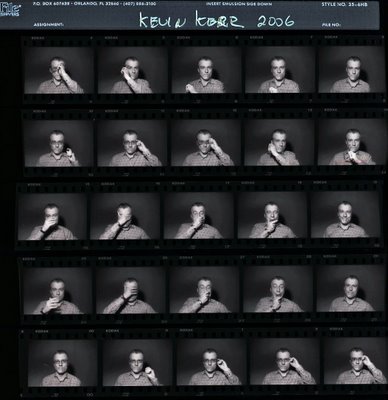
Last night at the opening of the Electric Company's Studies in Motion - The Hauntings of Eadweard Muybridge presented by the Playhouse Theatre Company, I missed Robert Chesterman very much.
During the intermission of the same play at the Frederick Wood Theatre in January 2006, I ran into red-haired, red-faced film director Robert Chesterman. A man who had been born in England and had been a TV and film pioneer at the CBC was wowed by the show. “I have seen just about everything in my life (he was 75) but I have never seen anything like this. It is fantastic.” I was just as amazed and delighted at the performance. But for the moment I had to put that aside. I saw a kind of hope in the older man that gave me an impetus to realize that there is much excitement left for me to see in my own life (I am 66). When Chesterman died the next year I remembered his excitement. I still have a bit of his hope for the new and undiscovered.
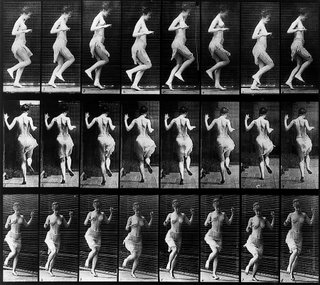
There is theatre, there is ballet, there is opera, there is film there is television. It is not often that any of these art disciplines mix or merge. Of late, most operas have excluded the traditional ballet that many productions incorporated in the 19th century. A recent production of Aida by the Vancouver Opera included some dance. One of my favourite Vancouver male dancers, Tod Woffinden was relegated to looking like an Apache Indian. The dance was terrible. I have seen many modern dance works that attempt to bring in projected video. Most of these have not satisfied me.
In Studies in Motion – The Hauntings of Eadweard Muybridge the folks at the Electric Theatre Company (actor Jonathon Young, director Kim Collier, below rigth, and playwright Kevin Kerr, above, decided to bring into their mix the choreography of Vancouver’s Crystal Pite, below, left. This was a felicitous decision and the result is a play that is dance. It is dance that is theatre. It is an amalgamation that is better than its two parts.
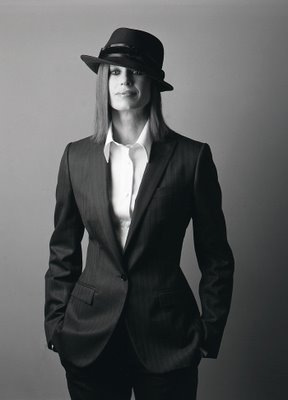
The play with the help of Crystal Pite’s choreography and music by Patrick Pennefather (well known in the Vancouver dance scene) somehow transported me into the 19 th century when science was an all-is-possible solution to the world’s ills. Robert Gardiner’s stark scenery of projected white lines and the human figures moving back in forth, draped and undraped, seemed all in a realistic black and white. I was watching Muybridge himself (Andrew Wheeler) perform his experiments in human and animal locomotion.
Eadweard Muybridge himself is ample proof that truth is far stranger than fiction. As an example you might consider that before the English born photographer began his motion studies he went off to take pictures in Guatemala and Panama under the name of Eduardo Santiago Muybridge. When he died in 1904 in Kingston upon Thames (where he was born) his memorial stone misspelled his name Eadweard Maybridge, and the crematorium register calls him Eudweard Muybridge!

Between his birth in 1830 and his cremation in 1904 Muybridge’s life was full of excitement, murder, a lawsuit all well covered by Kevin Kerr’s play. Perhaps the most singular event in Muybridge’s career involved a horse, a horse that should be as famous as the horses listed below. Unlike those other horses this one had a surname.
1. Bucephalus, Alexander the Great’s horse.
2. Cincinnatus, General Ulysses S. Grant’s horse.
3. Traveler, General Robert E. Lee’s horse.
4. Copenhagen, the Duke of Wellington’s horse at Waterloo.
5. Rocinante, Don Quixote’s horse.
Before Eadweard Muybridge came along, famous 19th century French painter Ernest Meissonier had his son Charles and several cuirassiers, veterans of the Napoleonic wars, galloping in his back garden. These studies in the motion of horses were for Meissonier's epic paintings of Napoleon in famous battles. The painter was obsessed with detail. Not being able to see the motion itself, Meissonier had a little railroad built in the garden and had assistants push his little railway car down a hill while a horse galloped on the side. Meissonier furiously sketched while trying to discern the pattern of the horse’s hooves, to no avail.


On June 15, 1878, on a clear and sunny day (good for photography involving slow film and slow lenses of the time) in Palo Alto, California, amid a gathering of art and sports journalists, Eadweard Muybridge photographed the first successful serial images of fast motion.
The subject of these photographs was the trotting horse, Abe Edgington, right, harnessed to a sulky ( a two-wheeled sit-down chariot-like carriage). The horse was owned by railroad builder and former governor, Leland Stanford. The images proved Stanford's theory that during a horse's running stride, there is a moment of suspension where no hooves are touching the ground.
What had begun as a topic of unresolvable debate among artists and horse enthusiasts now launched a new era in photography, and the birth of the motion picture. It also inspired artists of the time to finally and accurately depict the horse in motion. One of the most famous was Thomas Eakins’ (grandly played by Jonathon Young in Studies in Motion) painting A May Morning in the Park painted in 1879-80 as a result of careful observation of Muybridge’s work.
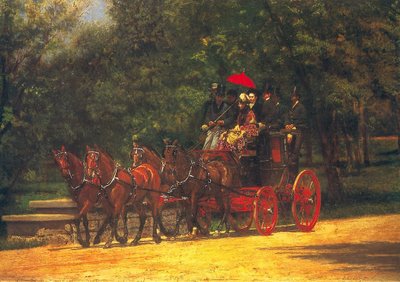
During the play 11 of the 12 performers manage to take all their clothes off. It is done humorously in some instances but in most the effect is scientific and clinical and should not offend anybody. I plan to return with my 11-year-old granddaughter Rebecca as I think this is a play that she will relish in years to come. There are several stand out performances. Allan Morgan is perfect and should not consider ever wanting to get in shape again. Those who will see the show will understand and snicker when I suggest Morgan never try hot potatoes. Jonathon Young had me confused for a while as he plays three roles. Two of them, as the womanizer Henry Larkyns and the other as the not-so-womanizer Thomas Eakins were superb.
And Andrew Wheeler is so good as Eadweard Muybridge that I plead that Kevin Kerr write a play very soon on Darwin. Wheeler would be the perfect Darwin. Then there is George Bernard Shaw, too.
The folks of the Playhouse Theatre Company know a good thing when it comes along. They are presenting this Electric Theatre Company production until April 18 at the Vancouver Playhouse.
Jonathan Young
Kim Collier, Jonathon Young and Kevin Kerr
Kevin Kerr
Kim Collier
Allan Morgan
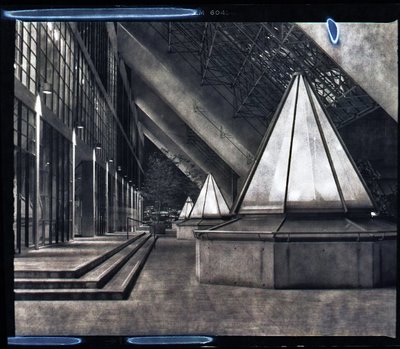
In my 35 years of being a photographer my photographs have been treated with respect. They may have appeared extra small, or smudged, or in the wrong colour but in almost ever case the pictures looked as I had taken them. Only once did I have a problem. The art director in question worked for a local business magazine. When I first met him he told me, “Alex give me a full frame photograph so I can crop the shit out of it.” I thought he was joking. I photographed, per instructions a gentleman holding an apple in his hand. When the magazine appeared the picture was of the gentleman’s hand holding the apple. I was furious.
In the middle 70s (I have been unable to find the exact date and not even in this Vancouver Sun article by Amy O’Brian was the date given) the CBC moved from its old and tired building on Georgia to its new facilities on Hamilton and Georgia. The fact is that Paul Merrick designed the new CBC building on Hamilton street and the structure won a Governor General’s Award. Somebody at the Corporation approved of the project and the unusual building was built. It seems to be almost as universally hated as the Eaton’s and now Sears building by Cesar Pelli.
I began taking pictures of variety shows at the new building as soon as it opened and I have “grown accustomed to its face” through the years. I liked the CBC cafeteria with the wonderful Shadbolt mural. I liked the cavernous studios, and the beautiful wood paneling of Studio One. I have heard memorable concerts there. Its acoustics are beautiful.
In the mid 80s Sean Rossiter wrote an article on the venerable Vancouver architectural firm Thompson, Berwick, Pratt and Partners. I was commissioned to photograph some of the firm’s notable structures at night. One of them was the CBC as Paul Merrick had designed it as an architect for that fim that gave us the Cenotaph, the Burrard Street Bridge and the BC Electric Building on Burrard.
I fell in love with the personality of architect Ned Pratt and I fell in love with architects and their architecture. I fell in love with the CBC at night as I took photographs of the curious pyramid-shaped skylights. For me the building is beautiful and functional.
A building’s design has to be respected and it has to be respected in the spirit of the times it was built. We might not like intricately baroque architecture in our Postmodern times. That does not mean that we must demolish baroque churches.
My friend, architect Abraham Rogatnick arrived in Vancouver in 1955 exactly when our main post office on Georgia had just been finished. Rogatnick was appalled at the structure. He dislikes it and thinks it occupies important city space that in this age of the internet a post office no longer merits. I think the post office was designed in the spirit of the monumental 50s when so much of the world had been destroyed by bombs. I love going into the post office to gaze at the lofty ceiling and imagining a cumulus cloud here and there. This building is Rumanian/Soviet architecture at its best. I like it. I like it as much as I like the CBC.

This is why I cannot abide when the city and the CBC without any clear mandate that I have been aware of have seen fit to surround and hide Merrick’s design with enough density condominiums that must even grate on Gordon Price who has been promoting city density for years.
What has emerged in the last few months is a structure that has to be as ugly as the two buildings that replaced our BC Electric, the BC Gas on Georgia and BC Hydro on Dunsmuir.
The West side of the CBC can be seen in the colour picture here. The parking lot for the truck (and entrance to Studios 40 and 41) has been mostly blocked by towers that wrap all around to the front on Hamilton. The towers are designed by the firm Hotson Bakker Boniface Haden. This firm has managed to emulate the common practice of ancient Mexican cultures that imposed their wills over the vanquished by building over the old pyramids new and even bigger pyramids. As soon as I can I will go and explore and see if I can still find Merrick's curious but lovely glass ones.

Warning! While I have often boasted that I never rant, what I have written below could be one. Read at your peril.
My uncle Tony had a technique with dealing with his nagging wife Sarita. “Yes dear, I will be there in a moment.” “Yes dear, I will do that today, without fail.” And then he would do as he pleased. The technique worked for 13 years. They were divorced when my uncle found an even more patient woman.
In 1975 when I arrived with my wife and two daughters to Vancouver I heard about a beautiful building that had been torn down. It was a department store called Eaton’s. I had no memory of it so the stories did not affect me. I felt differently in 1989 when the Georgia Medical Dental Building was demolished even after protracted protest. The building was beautiful. Now we only have the Marine Building to boast about in that area of our city.
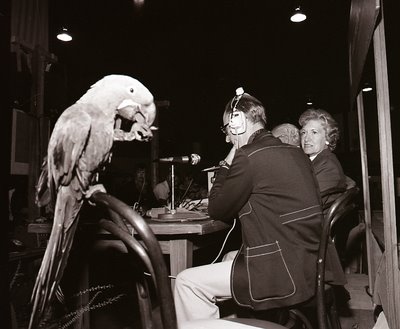
I see the Uncle Tony technique alive and well in Vancouver and in Canada. We sign petitions. We assert we do not want the Olympics. The results are always the same things are done in spite of protests and petitions.
As I walked today on Granville on my way to buy photo supplies at Leo’s Camera I had to brave noise, mud, fences and detour signs. Not only does it seem that all the protests and petitions against the Cambie construction of the Canada Line were useless but now I can see how Granville has been Cambied (I claim here and now the coining of the verb!).
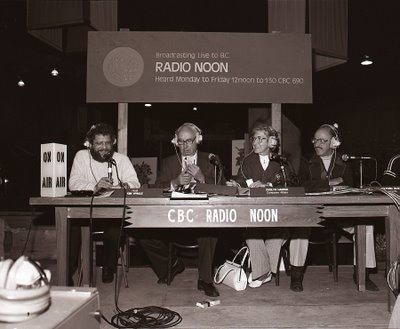
And so in the last week I have received many e-mails from friends and from people I don’t know to sign an E-protest to attempt to save the CBC from the budget cuts. By the easy and effortless technique of pressing the send button I can feel I am doing my best to save the CBC from itself.

Except for the use of drones and a few rockets here and there the use of the button has yet to take over completely in our human expertise at warfare. We still find it necessary to kill people by using weapons that send metal slugs through people. We press triggers and not buttons. But we are content to protest with buttons from the comfort of our homes. I am not promoting here anything violent at all in contrasting bullets with buttons. Whatever happened to calling our MP and demanding they act on our behalf? What if we shower our Vancouver Sun with protest letters? What if we find some way to convince Carole Taylor that it would no longer be conflict of any interest and that she could be our spokeswoman in a crusade to save and improve the CBC? Unfortunately we no longer have Daryl Duke to write intelligent essays on why the CBC is important to our lives.
With that e-mail command to send I am supposed to sleep nights in my knowledge that I have done all that is possible to save our beloved CBC. I use the word beloved with all honesty but I have been told that this feeling is of one in a minority.
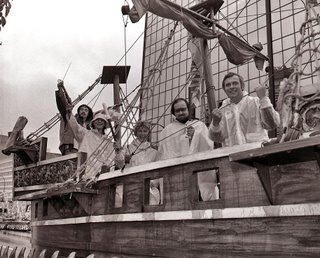
Our aboriginals have repeatedly asked for land and monetary compensation. The Uncle Tony Technique has been clearly used here. “Next year.” “Have patience. It will happen.” Years and years have passed with little being done for the plight of aboriginals. The Uncle Tony Technique relies on the proven fact that, at least here in Canada and in Vancouver, all protests peter out sooner or later. Just weather the storm is the corollary to the technique.
Every time I drive to Lillooet to visit my daughter and pass by the beautiful Lillooet train station I think of CN, BC Rail and the whole imbroglio of the legislature raids and the present BC government that is simply weathering the storm. This has worked every time, hasn’t it?
We can blog, and write letters to the editor about how we want to keep our CBC just the way it is. We can protest that CBC Radio is about the only media entity that keeps our province and other provinces together. I am sure it is important in keeping our country together.
Consider that Mark Forsythe’s noon to 2 program, BC Almanac. It is one of only two other radio programs (North by Nortwest and Hot Air) that has listeners across our province. From one of the old photographs here you can note that in the late 70s the program was only an hour and a half long. BC Almanac is now to be cut to only one hour. This could be the decision of some executive who works in what we have called (most accurately as it is indeed its name) The Corporation. All along many have complained that the problem with the Corporation is the personnel at the top - the corporate heads. Could it be a coincidence that both the CBC and the venerable American GMC both have products nobody wants? I don't quite think so. While I no longer dream of buying a Plymouth Fury I know that without my CBC Radio my radios would only then be obsolete.
We can protest that we want to keep and enjoy commercial free radio. We can cite all the advantages. We can protest that we want a fairly unbiased reporting that is not beholden to advertisers. But we will protest in vain. A friend pointed out to me that we are living in a post-radio-talk-host era. There are no Websters, Bannermans or Mairs to fan the flames of our recalcitrant almost flame-proof consciences.
In the end those of us who try to defend the CBC are accused of being elitists or snobs. We have to be elitists and snobs because some of us like the obsolete music of other centuries. We are deemed to be elitist because we want announcers with pleasant voices that have no lisps and or speech impediments.
Cut a piece of tin from a tin can and bend it back and forth. It will be surprisingly resilient. But after a few too many foldings the tin will separate in two. That is what is being done to our CBC in small increments. When it finally breaks nobody will care or have a memory of what it was. It will be our Georgia Medical Dental Building of our forgotten past. We will not miss what was so diluted so that by the time it ceases being what it was supposed to be we will have no memory. We will have no memory of what it was.
As for me I will not send any e-mail to Harper. As my friend Robert Blake erroneously used to say to me all the time, “You can’t win if you don’t buy a ticket.” I don’t believe this ticket has a chance in ---- of winning anything.
The pictures you see here I took one very rainy day in the late 70s. It was the day of the PNE parade. I remember that the CBC float was the good ship Mirthful. From the parade I went to the PNE and took some pictures of the CBC in action with llamas, parrots and spaghetti. It was all in good fun.
If you believe that sending an e-mail to Harper is going to help click here.
CBC
More CBC.
Even More CBC
And Even More CBC
More
More Again
French CBC

Last night at the opening of the Electric Company's Studies in Motion - The Hauntings of Eadweard Muybridge presented by the Playhouse Theatre Company, I missed Robert Chesterman very much.
During the intermission of the same play at the Frederick Wood Theatre in January 2006, I ran into red-haired, red-faced film director Robert Chesterman. A man who had been born in England and had been a TV and film pioneer at the CBC was wowed by the show. “I have seen just about everything in my life (he was 75) but I have never seen anything like this. It is fantastic.” I was just as amazed and delighted at the performance. But for the moment I had to put that aside. I saw a kind of hope in the older man that gave me an impetus to realize that there is much excitement left for me to see in my own life (I am 66). When Chesterman died the next year I remembered his excitement. I still have a bit of his hope for the new and undiscovered.

There is theatre, there is ballet, there is opera, there is film there is television. It is not often that any of these art disciplines mix or merge. Of late, most operas have excluded the traditional ballet that many productions incorporated in the 19th century. A recent production of Aida by the Vancouver Opera included some dance. One of my favourite Vancouver male dancers, Tod Woffinden was relegated to looking like an Apache Indian. The dance was terrible. I have seen many modern dance works that attempt to bring in projected video. Most of these have not satisfied me.
In Studies in Motion – The Hauntings of Eadweard Muybridge the folks at the Electric Theatre Company (actor Jonathon Young, director Kim Collier, below rigth, and playwright Kevin Kerr, above, decided to bring into their mix the choreography of Vancouver’s Crystal Pite, below, left. This was a felicitous decision and the result is a play that is dance. It is dance that is theatre. It is an amalgamation that is better than its two parts.

The play with the help of Crystal Pite’s choreography and music by Patrick Pennefather (well known in the Vancouver dance scene) somehow transported me into the 19 th century when science was an all-is-possible solution to the world’s ills. Robert Gardiner’s stark scenery of projected white lines and the human figures moving back in forth, draped and undraped, seemed all in a realistic black and white. I was watching Muybridge himself (Andrew Wheeler) perform his experiments in human and animal locomotion.
Eadweard Muybridge himself is ample proof that truth is far stranger than fiction. As an example you might consider that before the English born photographer began his motion studies he went off to take pictures in Guatemala and Panama under the name of Eduardo Santiago Muybridge. When he died in 1904 in Kingston upon Thames (where he was born) his memorial stone misspelled his name Eadweard Maybridge, and the crematorium register calls him Eudweard Muybridge!

Between his birth in 1830 and his cremation in 1904 Muybridge’s life was full of excitement, murder, a lawsuit all well covered by Kevin Kerr’s play. Perhaps the most singular event in Muybridge’s career involved a horse, a horse that should be as famous as the horses listed below. Unlike those other horses this one had a surname.
1. Bucephalus, Alexander the Great’s horse.
2. Cincinnatus, General Ulysses S. Grant’s horse.
3. Traveler, General Robert E. Lee’s horse.
4. Copenhagen, the Duke of Wellington’s horse at Waterloo.
5. Rocinante, Don Quixote’s horse.
Before Eadweard Muybridge came along, famous 19th century French painter Ernest Meissonier had his son Charles and several cuirassiers, veterans of the Napoleonic wars, galloping in his back garden. These studies in the motion of horses were for Meissonier's epic paintings of Napoleon in famous battles. The painter was obsessed with detail. Not being able to see the motion itself, Meissonier had a little railroad built in the garden and had assistants push his little railway car down a hill while a horse galloped on the side. Meissonier furiously sketched while trying to discern the pattern of the horse’s hooves, to no avail.


On June 15, 1878, on a clear and sunny day (good for photography involving slow film and slow lenses of the time) in Palo Alto, California, amid a gathering of art and sports journalists, Eadweard Muybridge photographed the first successful serial images of fast motion.
The subject of these photographs was the trotting horse, Abe Edgington, right, harnessed to a sulky ( a two-wheeled sit-down chariot-like carriage). The horse was owned by railroad builder and former governor, Leland Stanford. The images proved Stanford's theory that during a horse's running stride, there is a moment of suspension where no hooves are touching the ground.
What had begun as a topic of unresolvable debate among artists and horse enthusiasts now launched a new era in photography, and the birth of the motion picture. It also inspired artists of the time to finally and accurately depict the horse in motion. One of the most famous was Thomas Eakins’ (grandly played by Jonathon Young in Studies in Motion) painting A May Morning in the Park painted in 1879-80 as a result of careful observation of Muybridge’s work.

During the play 11 of the 12 performers manage to take all their clothes off. It is done humorously in some instances but in most the effect is scientific and clinical and should not offend anybody. I plan to return with my 11-year-old granddaughter Rebecca as I think this is a play that she will relish in years to come. There are several stand out performances. Allan Morgan is perfect and should not consider ever wanting to get in shape again. Those who will see the show will understand and snicker when I suggest Morgan never try hot potatoes. Jonathon Young had me confused for a while as he plays three roles. Two of them, as the womanizer Henry Larkyns and the other as the not-so-womanizer Thomas Eakins were superb.
And Andrew Wheeler is so good as Eadweard Muybridge that I plead that Kevin Kerr write a play very soon on Darwin. Wheeler would be the perfect Darwin. Then there is George Bernard Shaw, too.
The folks of the Playhouse Theatre Company know a good thing when it comes along. They are presenting this Electric Theatre Company production until April 18 at the Vancouver Playhouse.
Jonathan Young
Kim Collier, Jonathon Young and Kevin Kerr
Kevin Kerr
Kim Collier
Allan Morgan
The Densification Of Paul Merrick's CBC
Thursday, April 02, 2009

In my 35 years of being a photographer my photographs have been treated with respect. They may have appeared extra small, or smudged, or in the wrong colour but in almost ever case the pictures looked as I had taken them. Only once did I have a problem. The art director in question worked for a local business magazine. When I first met him he told me, “Alex give me a full frame photograph so I can crop the shit out of it.” I thought he was joking. I photographed, per instructions a gentleman holding an apple in his hand. When the magazine appeared the picture was of the gentleman’s hand holding the apple. I was furious.
In the middle 70s (I have been unable to find the exact date and not even in this Vancouver Sun article by Amy O’Brian was the date given) the CBC moved from its old and tired building on Georgia to its new facilities on Hamilton and Georgia. The fact is that Paul Merrick designed the new CBC building on Hamilton street and the structure won a Governor General’s Award. Somebody at the Corporation approved of the project and the unusual building was built. It seems to be almost as universally hated as the Eaton’s and now Sears building by Cesar Pelli.
I began taking pictures of variety shows at the new building as soon as it opened and I have “grown accustomed to its face” through the years. I liked the CBC cafeteria with the wonderful Shadbolt mural. I liked the cavernous studios, and the beautiful wood paneling of Studio One. I have heard memorable concerts there. Its acoustics are beautiful.
In the mid 80s Sean Rossiter wrote an article on the venerable Vancouver architectural firm Thompson, Berwick, Pratt and Partners. I was commissioned to photograph some of the firm’s notable structures at night. One of them was the CBC as Paul Merrick had designed it as an architect for that fim that gave us the Cenotaph, the Burrard Street Bridge and the BC Electric Building on Burrard.
I fell in love with the personality of architect Ned Pratt and I fell in love with architects and their architecture. I fell in love with the CBC at night as I took photographs of the curious pyramid-shaped skylights. For me the building is beautiful and functional.
A building’s design has to be respected and it has to be respected in the spirit of the times it was built. We might not like intricately baroque architecture in our Postmodern times. That does not mean that we must demolish baroque churches.
My friend, architect Abraham Rogatnick arrived in Vancouver in 1955 exactly when our main post office on Georgia had just been finished. Rogatnick was appalled at the structure. He dislikes it and thinks it occupies important city space that in this age of the internet a post office no longer merits. I think the post office was designed in the spirit of the monumental 50s when so much of the world had been destroyed by bombs. I love going into the post office to gaze at the lofty ceiling and imagining a cumulus cloud here and there. This building is Rumanian/Soviet architecture at its best. I like it. I like it as much as I like the CBC.

This is why I cannot abide when the city and the CBC without any clear mandate that I have been aware of have seen fit to surround and hide Merrick’s design with enough density condominiums that must even grate on Gordon Price who has been promoting city density for years.
What has emerged in the last few months is a structure that has to be as ugly as the two buildings that replaced our BC Electric, the BC Gas on Georgia and BC Hydro on Dunsmuir.
The West side of the CBC can be seen in the colour picture here. The parking lot for the truck (and entrance to Studios 40 and 41) has been mostly blocked by towers that wrap all around to the front on Hamilton. The towers are designed by the firm Hotson Bakker Boniface Haden. This firm has managed to emulate the common practice of ancient Mexican cultures that imposed their wills over the vanquished by building over the old pyramids new and even bigger pyramids. As soon as I can I will go and explore and see if I can still find Merrick's curious but lovely glass ones.
Our Beloved CBC, Parrots, Llamas, Midgets & Spaghetti
Wednesday, April 01, 2009

Warning! While I have often boasted that I never rant, what I have written below could be one. Read at your peril.
My uncle Tony had a technique with dealing with his nagging wife Sarita. “Yes dear, I will be there in a moment.” “Yes dear, I will do that today, without fail.” And then he would do as he pleased. The technique worked for 13 years. They were divorced when my uncle found an even more patient woman.
In 1975 when I arrived with my wife and two daughters to Vancouver I heard about a beautiful building that had been torn down. It was a department store called Eaton’s. I had no memory of it so the stories did not affect me. I felt differently in 1989 when the Georgia Medical Dental Building was demolished even after protracted protest. The building was beautiful. Now we only have the Marine Building to boast about in that area of our city.

I see the Uncle Tony technique alive and well in Vancouver and in Canada. We sign petitions. We assert we do not want the Olympics. The results are always the same things are done in spite of protests and petitions.
As I walked today on Granville on my way to buy photo supplies at Leo’s Camera I had to brave noise, mud, fences and detour signs. Not only does it seem that all the protests and petitions against the Cambie construction of the Canada Line were useless but now I can see how Granville has been Cambied (I claim here and now the coining of the verb!).

And so in the last week I have received many e-mails from friends and from people I don’t know to sign an E-protest to attempt to save the CBC from the budget cuts. By the easy and effortless technique of pressing the send button I can feel I am doing my best to save the CBC from itself.

Except for the use of drones and a few rockets here and there the use of the button has yet to take over completely in our human expertise at warfare. We still find it necessary to kill people by using weapons that send metal slugs through people. We press triggers and not buttons. But we are content to protest with buttons from the comfort of our homes. I am not promoting here anything violent at all in contrasting bullets with buttons. Whatever happened to calling our MP and demanding they act on our behalf? What if we shower our Vancouver Sun with protest letters? What if we find some way to convince Carole Taylor that it would no longer be conflict of any interest and that she could be our spokeswoman in a crusade to save and improve the CBC? Unfortunately we no longer have Daryl Duke to write intelligent essays on why the CBC is important to our lives.
With that e-mail command to send I am supposed to sleep nights in my knowledge that I have done all that is possible to save our beloved CBC. I use the word beloved with all honesty but I have been told that this feeling is of one in a minority.

Our aboriginals have repeatedly asked for land and monetary compensation. The Uncle Tony Technique has been clearly used here. “Next year.” “Have patience. It will happen.” Years and years have passed with little being done for the plight of aboriginals. The Uncle Tony Technique relies on the proven fact that, at least here in Canada and in Vancouver, all protests peter out sooner or later. Just weather the storm is the corollary to the technique.
Every time I drive to Lillooet to visit my daughter and pass by the beautiful Lillooet train station I think of CN, BC Rail and the whole imbroglio of the legislature raids and the present BC government that is simply weathering the storm. This has worked every time, hasn’t it?
We can blog, and write letters to the editor about how we want to keep our CBC just the way it is. We can protest that CBC Radio is about the only media entity that keeps our province and other provinces together. I am sure it is important in keeping our country together.
Consider that Mark Forsythe’s noon to 2 program, BC Almanac. It is one of only two other radio programs (North by Nortwest and Hot Air) that has listeners across our province. From one of the old photographs here you can note that in the late 70s the program was only an hour and a half long. BC Almanac is now to be cut to only one hour. This could be the decision of some executive who works in what we have called (most accurately as it is indeed its name) The Corporation. All along many have complained that the problem with the Corporation is the personnel at the top - the corporate heads. Could it be a coincidence that both the CBC and the venerable American GMC both have products nobody wants? I don't quite think so. While I no longer dream of buying a Plymouth Fury I know that without my CBC Radio my radios would only then be obsolete.
We can protest that we want to keep and enjoy commercial free radio. We can cite all the advantages. We can protest that we want a fairly unbiased reporting that is not beholden to advertisers. But we will protest in vain. A friend pointed out to me that we are living in a post-radio-talk-host era. There are no Websters, Bannermans or Mairs to fan the flames of our recalcitrant almost flame-proof consciences.
In the end those of us who try to defend the CBC are accused of being elitists or snobs. We have to be elitists and snobs because some of us like the obsolete music of other centuries. We are deemed to be elitist because we want announcers with pleasant voices that have no lisps and or speech impediments.
Cut a piece of tin from a tin can and bend it back and forth. It will be surprisingly resilient. But after a few too many foldings the tin will separate in two. That is what is being done to our CBC in small increments. When it finally breaks nobody will care or have a memory of what it was. It will be our Georgia Medical Dental Building of our forgotten past. We will not miss what was so diluted so that by the time it ceases being what it was supposed to be we will have no memory. We will have no memory of what it was.
As for me I will not send any e-mail to Harper. As my friend Robert Blake erroneously used to say to me all the time, “You can’t win if you don’t buy a ticket.” I don’t believe this ticket has a chance in ---- of winning anything.
The pictures you see here I took one very rainy day in the late 70s. It was the day of the PNE parade. I remember that the CBC float was the good ship Mirthful. From the parade I went to the PNE and took some pictures of the CBC in action with llamas, parrots and spaghetti. It was all in good fun.
If you believe that sending an e-mail to Harper is going to help click here.
CBC
More CBC.
Even More CBC
And Even More CBC
More
More Again
French CBC






